Recombinant Microorganism And Method For Production Of Formic Acid By Using Same
Kim; Yong Hwan ; et al.
U.S. patent application number 16/495680 was filed with the patent office on 2020-03-26 for recombinant microorganism and method for production of formic acid by using same. This patent application is currently assigned to UNIST(ULSAN NATIONAL INSTITUTE OF SCIENCE AND TECHNOLOGY). The applicant listed for this patent is UNIST(ULSAN NATIONAL INSTITUTE OF SCIENCE AND TECHNOLOGY). Invention is credited to Jung Ho Jang, Byoung Wook Jeon, Yong Hwan Kim.
| Application Number | 20200095620 16/495680 |
| Document ID | / |
| Family ID | 66539776 |
| Filed Date | 2020-03-26 |
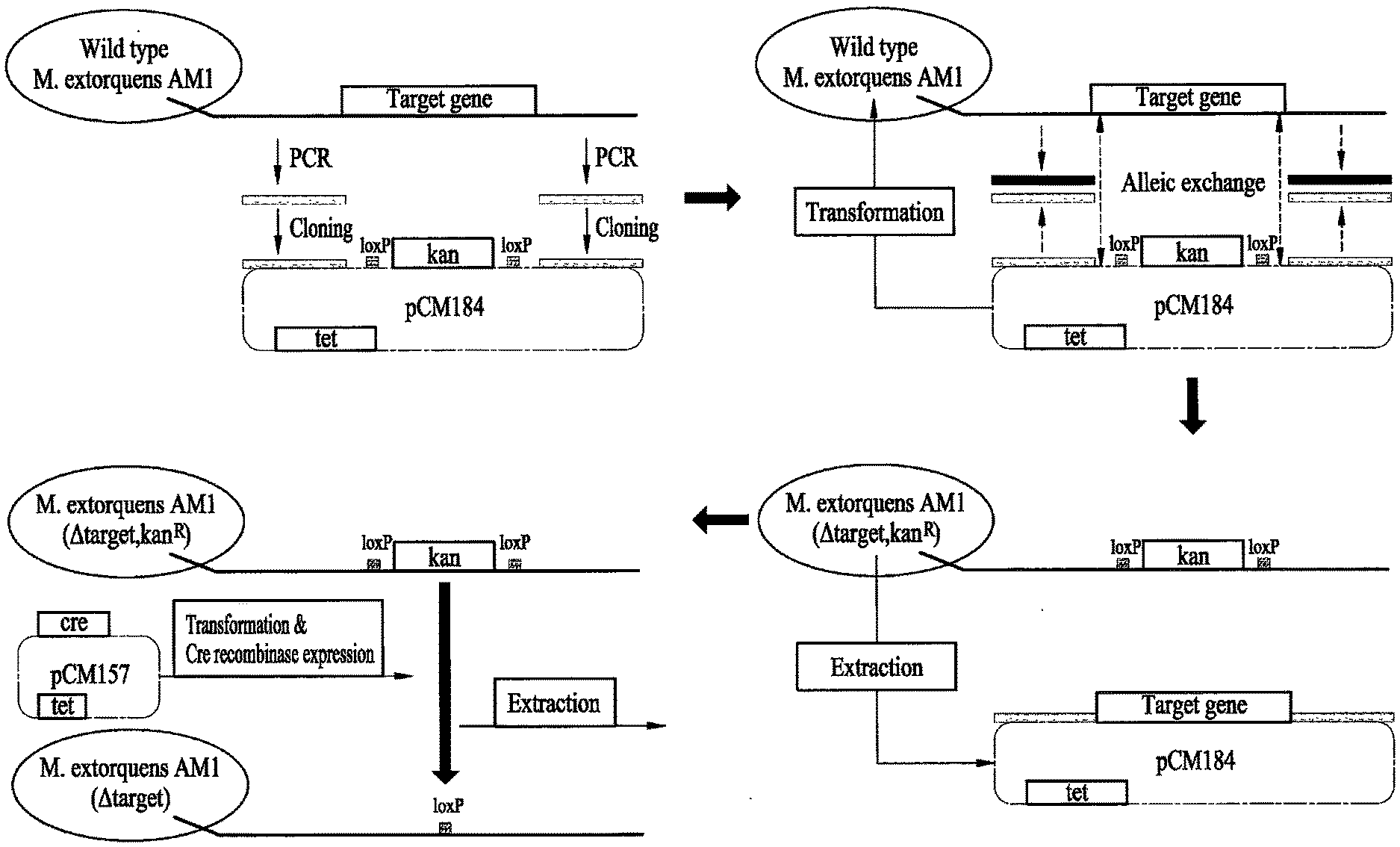

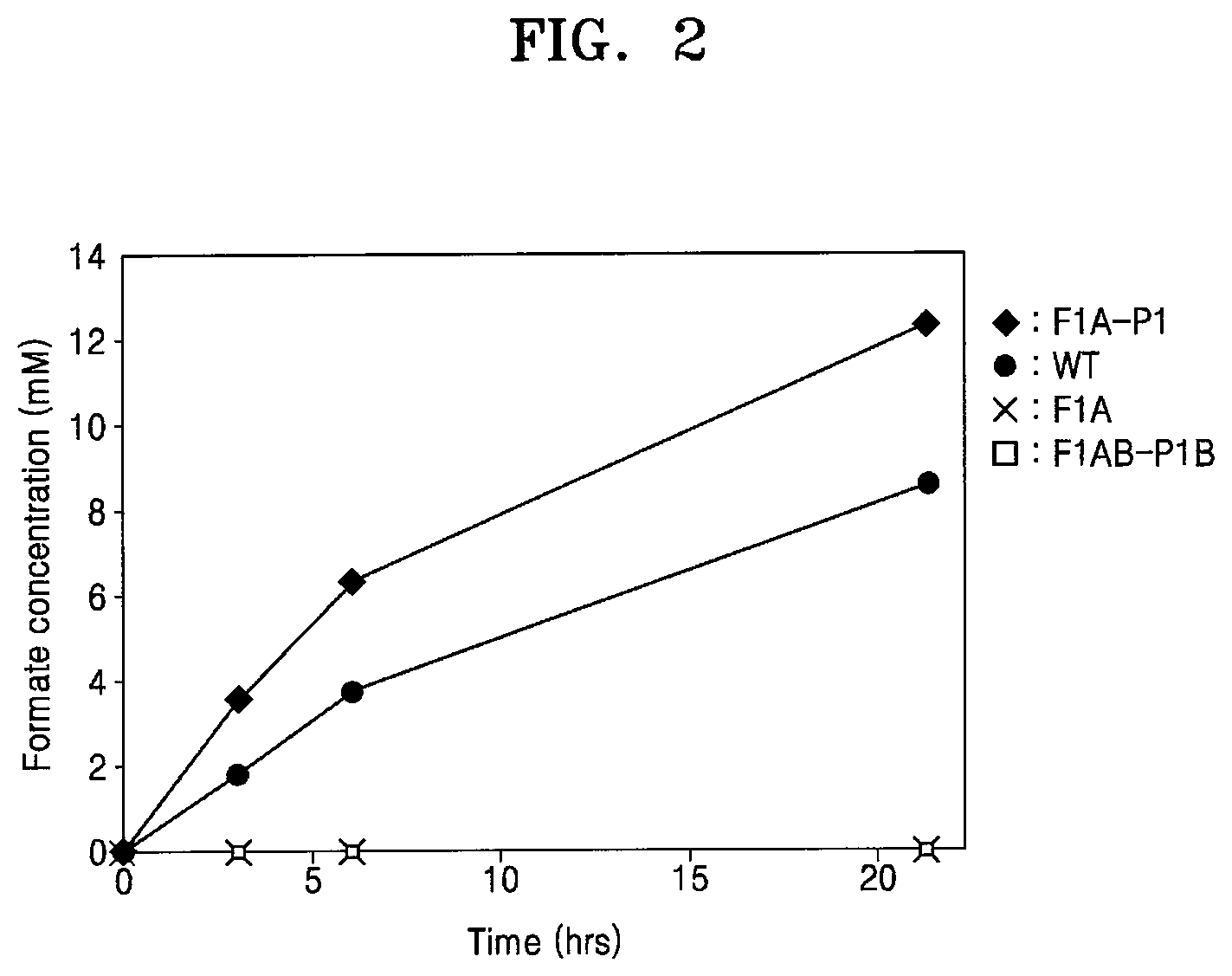
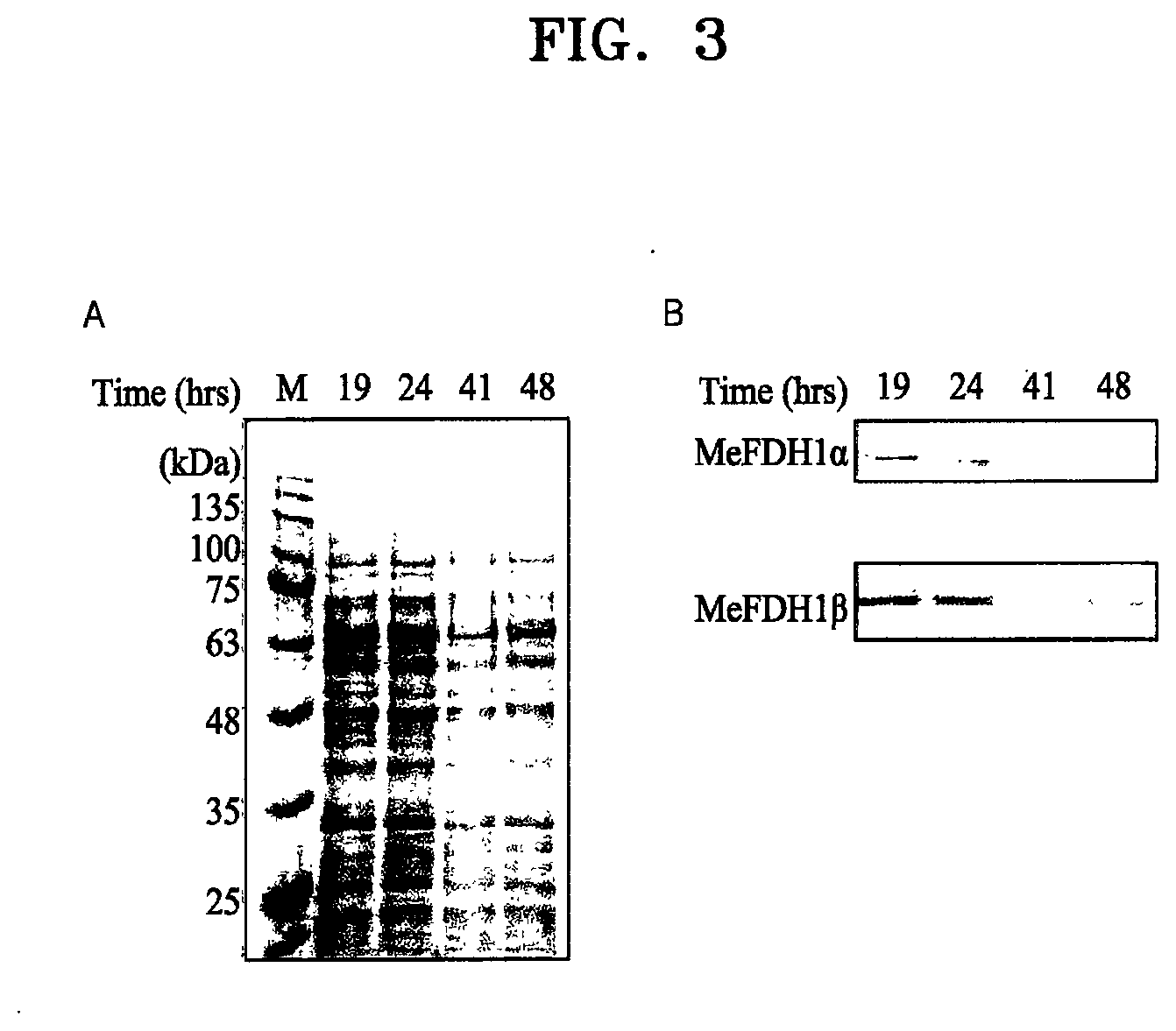
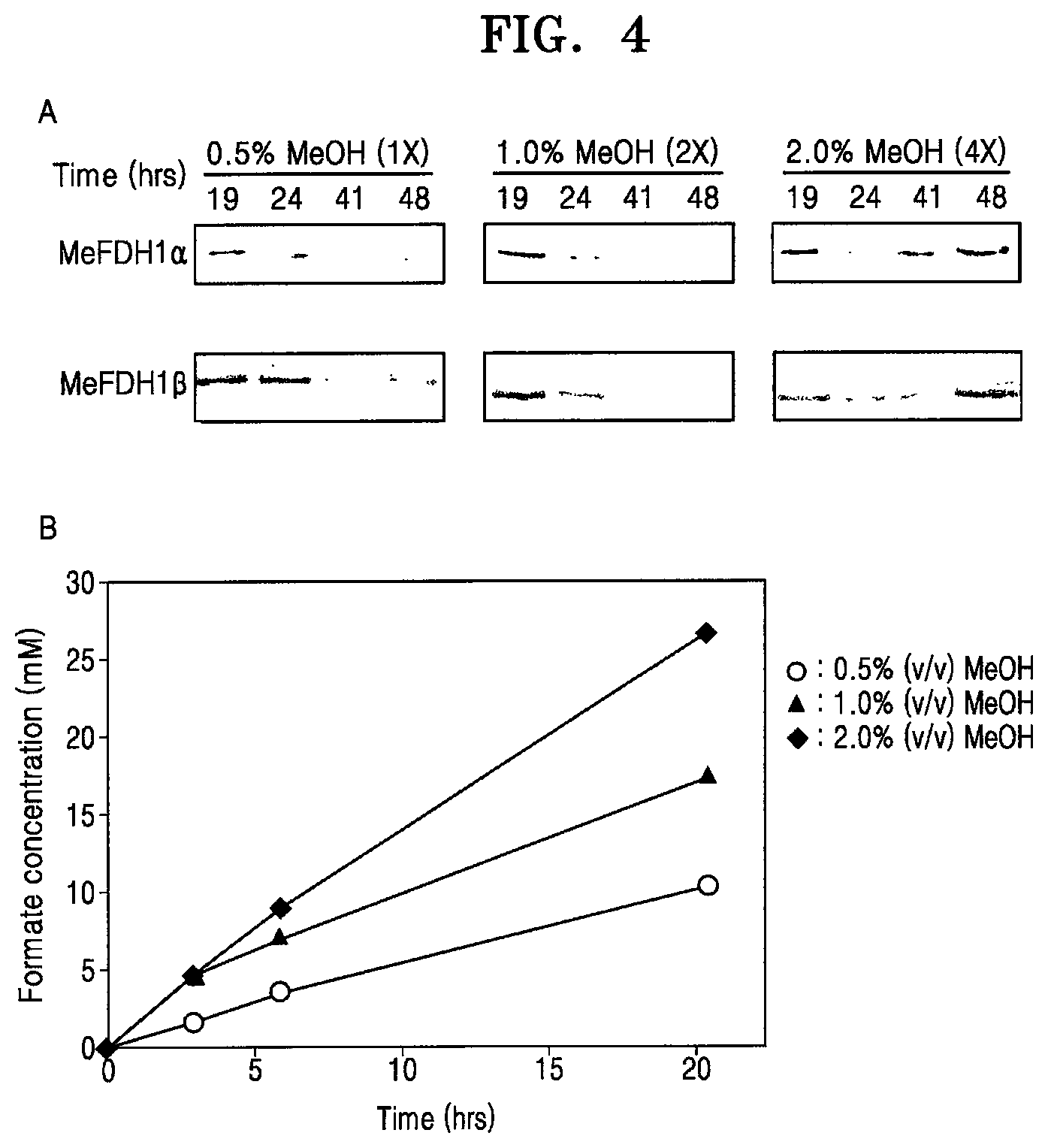
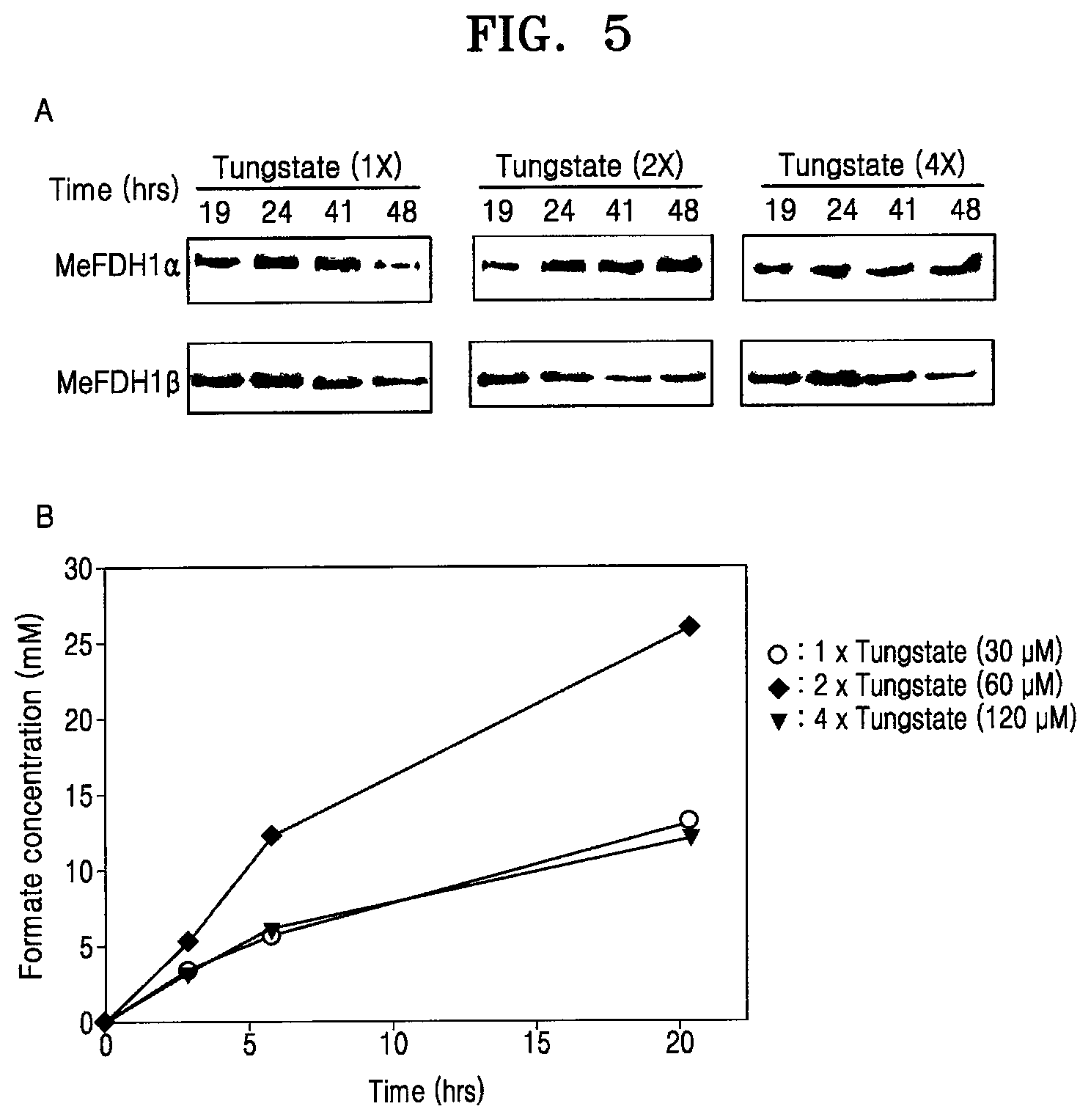
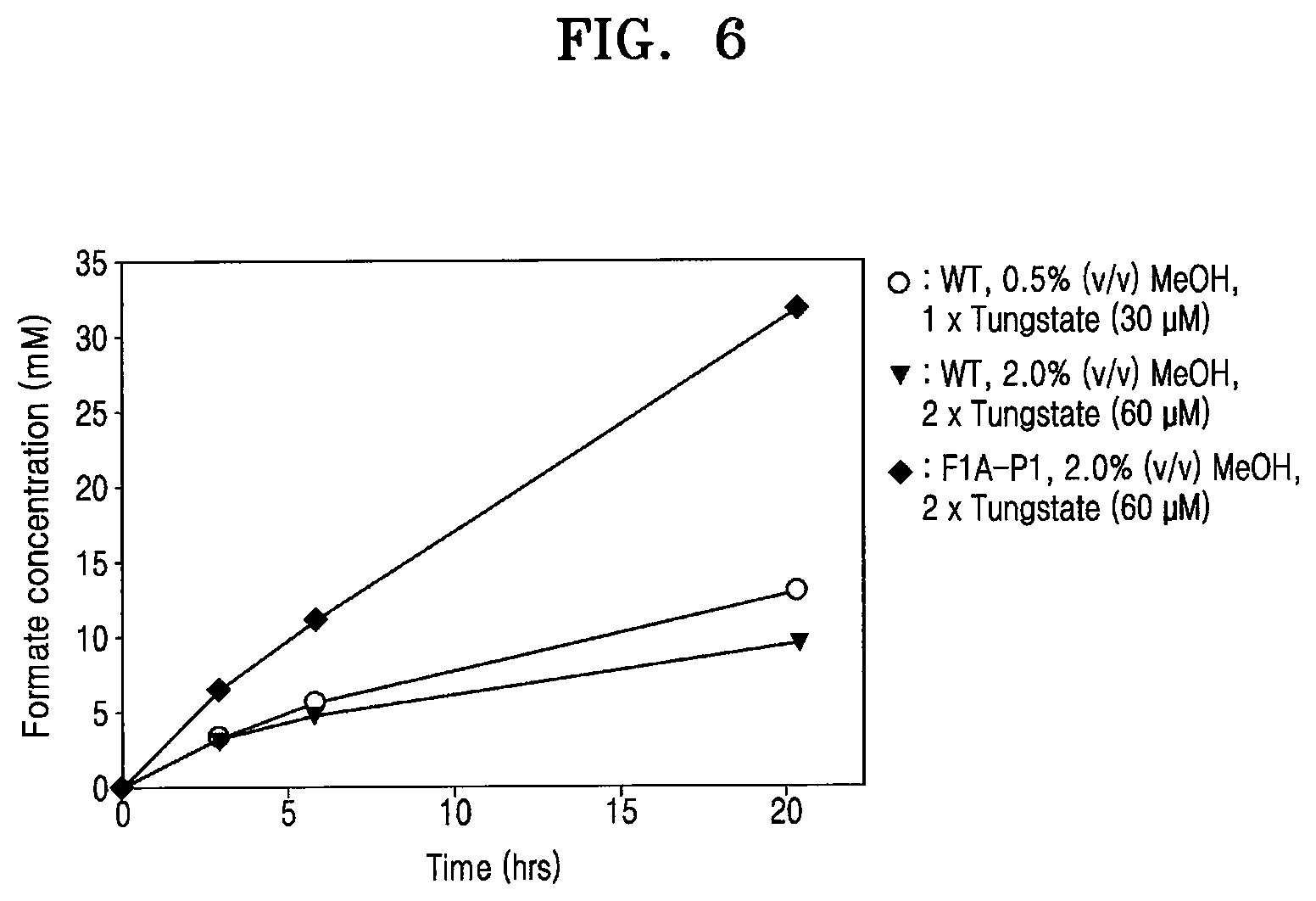
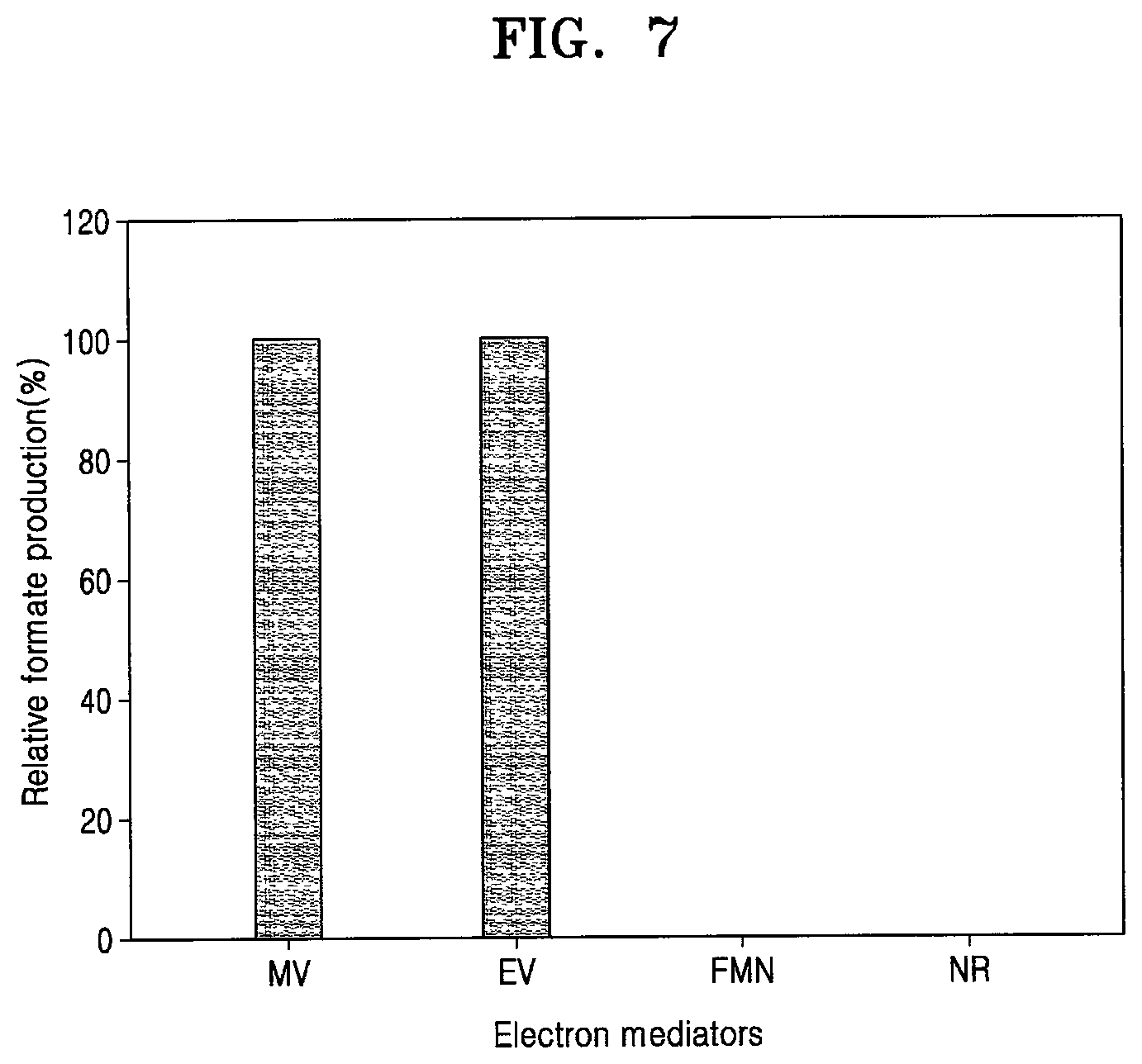
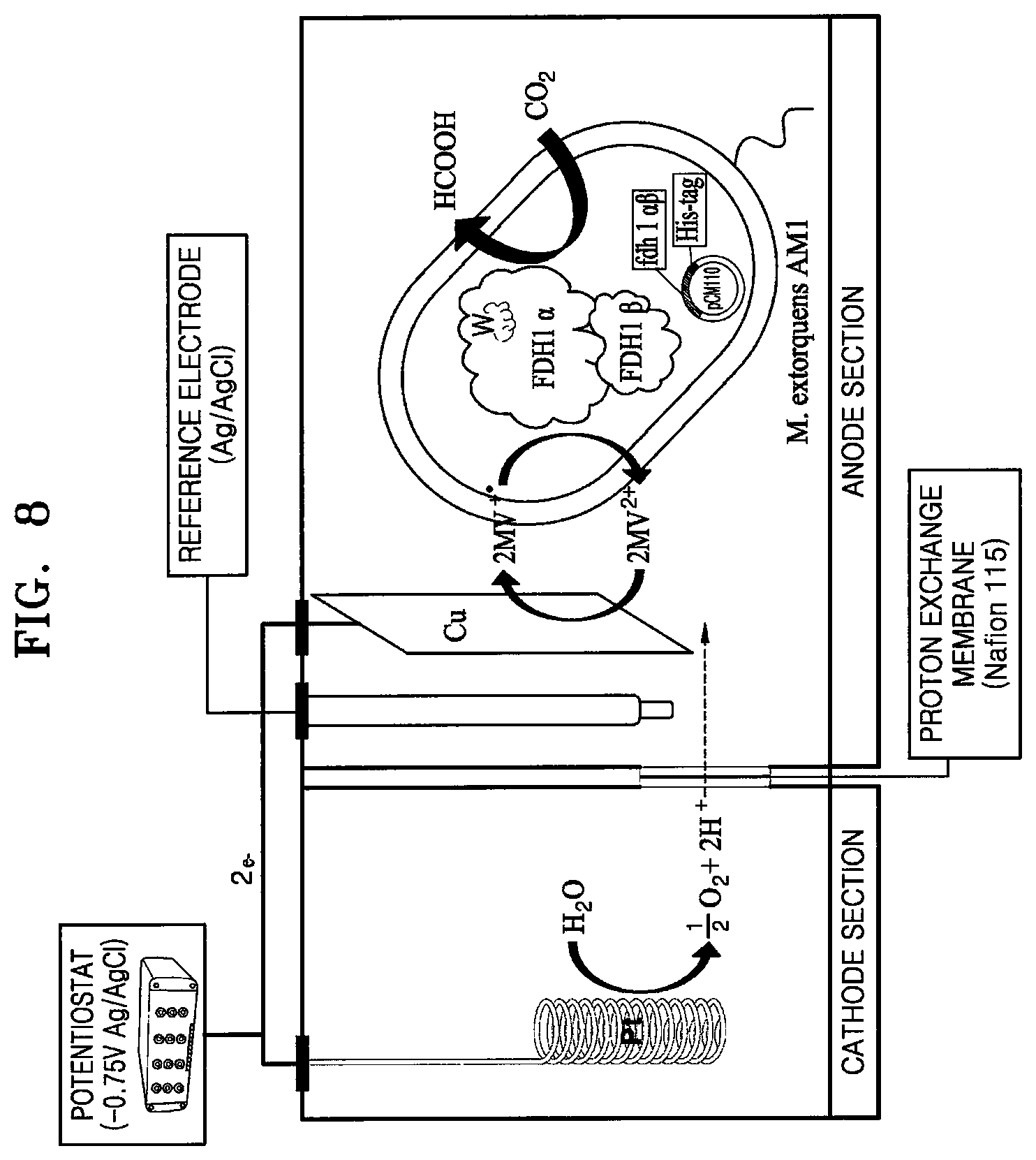
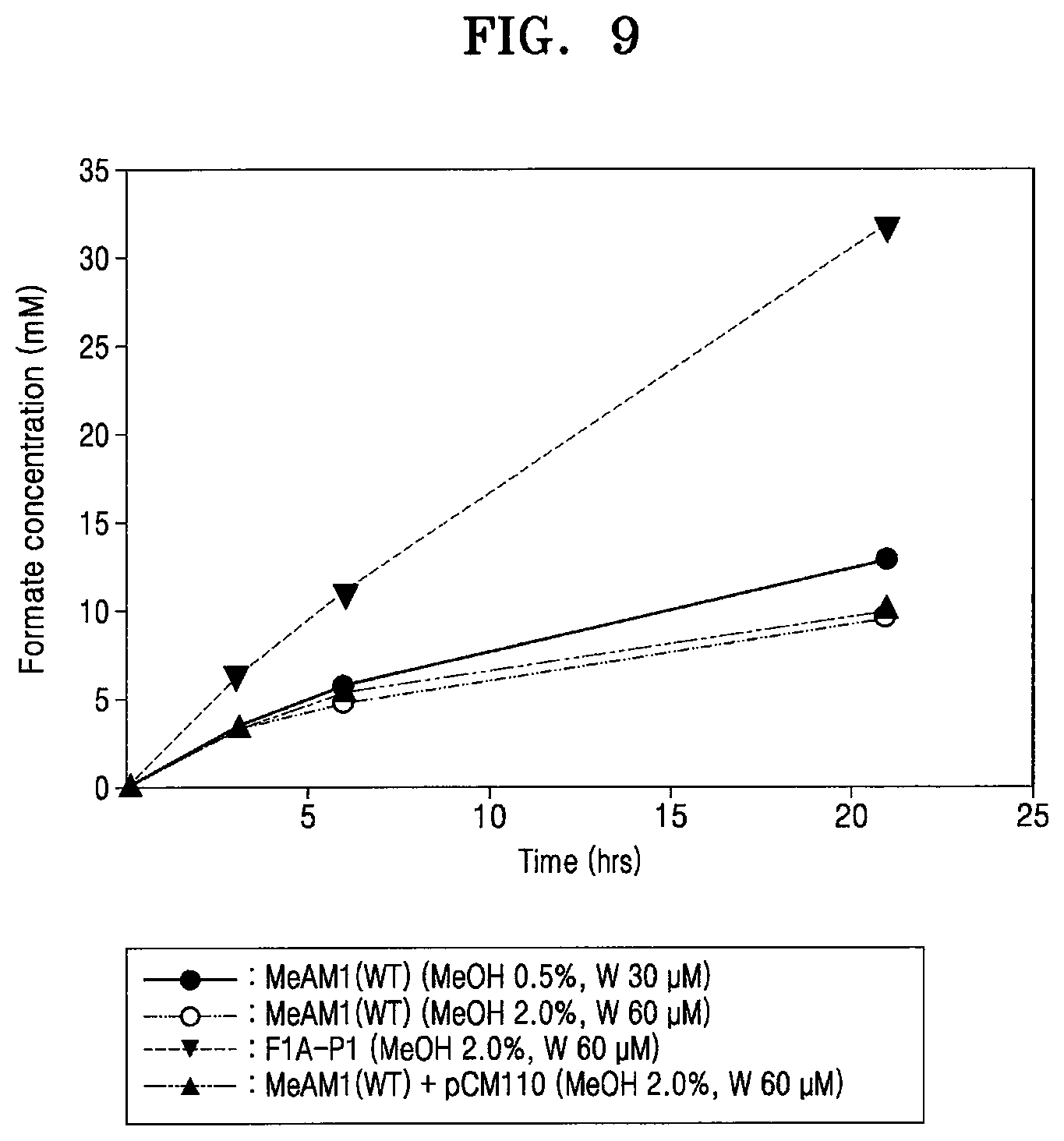
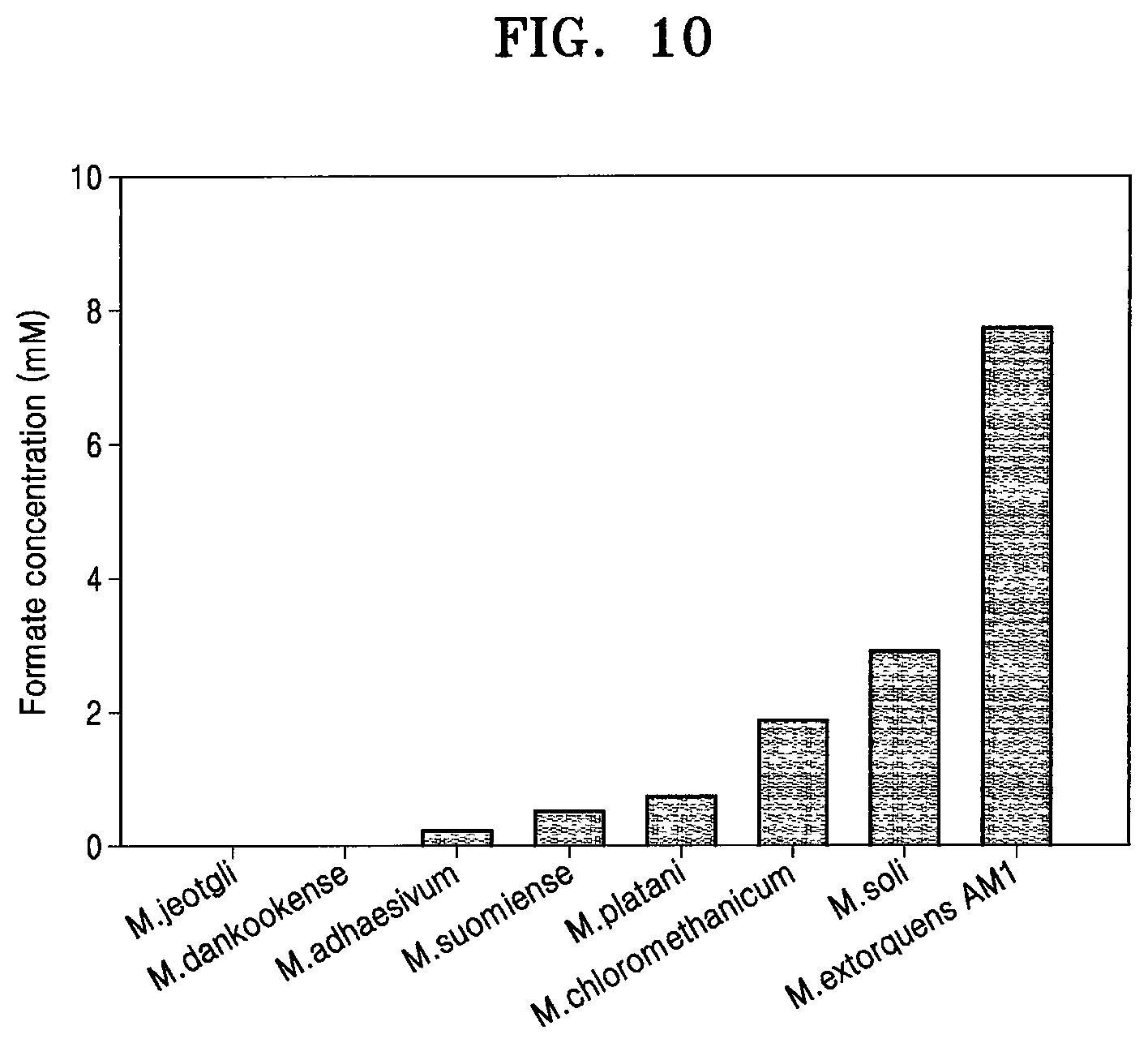
| United States Patent Application | 20200095620 |
| Kind Code | A1 |
| Kim; Yong Hwan ; et al. | March 26, 2020 |
RECOMBINANT MICROORGANISM AND METHOD FOR PRODUCTION OF FORMIC ACID BY USING SAME
Abstract
The present invention relates to a recombinant microorganism for producing formic acid, which has a formate dehydrogenase 1 alpha subunit (FDH1.alpha.)-encoding endogenous gene deleted therefrom and an FDH1-encoding exogenous gene introduced thereinto, and a method for production of formic acid by using the microorganism.
| Inventors: | Kim; Yong Hwan; (Ulsan, KR) ; Jang; Jung Ho; (Ulsan, KR) ; Jeon; Byoung Wook; (Ulsan, KR) | ||||||||||
| Applicant: |
|
||||||||||
|---|---|---|---|---|---|---|---|---|---|---|---|
| Assignee: | UNIST(ULSAN NATIONAL INSTITUTE OF
SCIENCE AND TECHNOLOGY) Ulsan KR |
||||||||||
| Family ID: | 66539776 | ||||||||||
| Appl. No.: | 16/495680 | ||||||||||
| Filed: | November 14, 2018 | ||||||||||
| PCT Filed: | November 14, 2018 | ||||||||||
| PCT NO: | PCT/KR2018/013894 | ||||||||||
| 371 Date: | September 19, 2019 |
| Current U.S. Class: | 1/1 |
| Current CPC Class: | C12N 9/0093 20130101; C12N 15/74 20130101; C12R 1/07 20130101; C12P 7/40 20130101; C12Y 117/01 20130101; C12N 1/20 20130101 |
| International Class: | C12P 7/40 20060101 C12P007/40; C12N 15/74 20060101 C12N015/74; C12N 1/20 20060101 C12N001/20; C12R 1/07 20060101 C12R001/07 |
Foreign Application Data
| Date | Code | Application Number |
|---|---|---|
| Nov 15, 2017 | KR | 10-2017-0152507 |
Claims
1. A recombinant microorganism for producing formate, from which an endogenous gene encoding formate dehydrogenase 1 alpha subunit (FDH1.alpha.) is deleted and into which an exogenous gene encoding formate dehydrogenase 1 (FDH1) is introduced.
2. The recombinant microorganism of claim 1, wherein the recombinant microorganism is modified from a microorganism of the genus Methylobacterium.
3. The recombinant microorganism of claim 2, wherein the microorganism of the genus Methylobacterium is selected from the group consisting of M. adhaesivum, M. aerolatum, M. aminovorans, M. aquaticum, M. brachiatum, M. brachythecii, M. bullatum, M. cerastii, M. chloromethanicum, M. dankookense, M. extorquens, M. fujisawaense, M. gnaphalii, M. goesingense, M. gossipiicola, M. gregans, M. haplocladii, M. hispanicum, M. iners, M. isbiliense, M. jeotgali, M. komagatae, M. longum, M. marchantiae, M. mesophilicum, M. nodulans, M. organophilum, M. oryzae, M. oxalidis, M. persicinum, M. phyllosphaerae, M. phyllostachyos, M. platani, M. podarium, M. populi, M. pseudosasae, M. pseudosasicola, M. radiotolerans, M. rhodesianum, M. rhodinum, M. salsuginis, M. soli, M. suomiense, M. tardum, M. tarhaniae, M. thiocyanatum, M. thuringiense, M. trifolii, M. variabile, and M. zatmanii.
4. The recombinant microorganism of claim 1, wherein the recombinant microorganism is modified from a microorganism of the genus Methylobacterium, and the microorganism of the genus Methylobacterium produces formate.
5. The recombinant microorganism of claim 1, wherein the microorganism of the genus Methylobacterium is selected from the group consisting of M. adhaesivum, M. chloromethanicum, M. suomiense, M. platani, M. soli, and M. extorquens.
6. The recombinant microorganism of claim 2, wherein the microorganism of the genus Methylobacterium is Methylobacterium extorquens.
7. The recombinant microorganism of claim 1, wherein the recombinant microorganism is cultured in an electrical or electrochemical system.
8. The recombinant microorganism of claim 7, wherein the electrochemical system is an electrochemical carbon dioxide reduction system.
9. The recombinant microorganism of claim 1, wherein the exogenous gene is introduced by a vector.
10. The recombinant microorganism of claim 1, wherein the vector comprises a PmxaF promoter.
11. The recombinant microorganism of claim 1, wherein an amount of formate produced by the recombinant microorganism is regulated by a methanol concentration.
12. The recombinant microorganism of claim 1, wherein the recombinant microorganism is cultured in an environment in which tungstate is present at a concentration of more than 30 .mu.M and less than 120 .mu.M.
13. The recombinant microorganism of claim 1, wherein the recombinant microorganism is cultured in an environment in which methyl viologen, ethyl viologen, or a combination thereof is present.
14. The recombinant microorganism of claim 1, wherein the recombinant microorganism is Accession No. KCTC 13388BP.
15. The recombinant microorganism of claim 1, a method of producing formate, the method comprising culturing the microorganism of claim 1 in a medium.
16. The method of claim 15, further comprising saturating the medium with carbon dioxide; and electrically or electrochemically treating the medium.
17. The method of claim 15, wherein the medium further comprises methanol.
18. The method of claim 15, wherein the medium further comprises tungsten.
19. The method of claim 15, wherein the medium further comprises an electron mediator that transfers electrons to FDH1.
Description
TECHNICAL FIELD
[0001] The present disclosure relates to a microorganism, specifically, a recombinant microorganism of the genus Methylobacterium having increased production of formate, from which an endogenous formate dehydrogenase 1 alpha subunit (fdh1.alpha.) gene is deleted and in which an exogenous fdh1 is expressed, and a method of preparing formate using the recombinant microorganism.
BACKGROUND ART
[0002] The rapid development of a wide range of industries using fossil fuels has led to drastically increased levels of atmospheric carbon dioxide [1]. Furthermore, a vast number of papers confirmed that elevated carbon dioxide levels in the atmosphere are a critical factor in global warming via greenhouse effects [1-3]. Therefore, conversion of carbon dioxide to value-added chemicals has been posited as an indispensable technology for slowing down the rate of atmospheric accumulation of carbon dioxide. Fortunately, carbon dioxide is a promising renewable source to produce environmentally friendly chemical platforms such as formate, dimethyl carbonate, polymers thereof, etc. [4].
[0003] Among many candidates that may be produced from carbon dioxide, formate is one of the most ideal chemicals in terms of economic and environmental benefits [5]. In particular, a direct formate fuel cell (DFFC) that converts formate to electrical energy has been suggested as a solution for renewable energy storage since energy generated from various renewable sources such as wind, solar, and hydro is able to be easily stored in formate. Additionally, formate is advantageous in that it is able to be safely transported, as compared with hydrogen gas, because formate is non-flammable, non-toxic, and inert in the environment [6, 7].
[0004] Despite the promising potential, existing technologies for converting carbon dioxide into valuable compounds harbor critical limitations such as harsh reaction conditions and requirements of rare precious metal catalysts and expensive reducing agents such as hydrogen gas, hydride, etc. [8, 9]. Even though electro-catalysis of carbon dioxide is a promising alternative in terms of relatively low electrical energy costs, some chemical electro-catalysts frequently demonstrate insufficient reaction selectivity during the conversion of carbon dioxide to formate due to the production of hydrogen gas as a by-product at a significant rate [10]. Accordingly, enzyme-based electro-catalyzed production of formate from carbon dioxide has received greater attention due to its exceptional selectivity for formate [11-14]. However, to render formate production from carbon dioxide feasible, effective oxygen-tolerant biocatalysts capable of directly using electrons supplied from a cathode are urgently needed [15].
[0005] In the petrochemical industry, a technology for supplying a C1 compound as a raw material is a very important basic step. This technology is called `C1 chemistry`, and in the field of C1 chemistry, attempts have been made to obtain C1 compounds from microorganisms because of limited petroleum fuel, as well as environmental and economic reasons. In the C1 chemistry, conversion of carbon dioxide to formate is recognized as a fundamental step in building C1 chemical platforms. Among numerous microorganisms for building C1 chemical platforms, Methylobacterium extorquens AM1 was reported to exhibit remarkable activity to convert carbon dioxide into formate. The present inventors have reported a novel approach for the conversion of carbon dioxide to formate through electro-catalysis using Methylobacterium extorquens AM1 as a whole-cell biocatalyst. The present inventors demonstrated that Methylobacterium extorquens AM1 has the ability to produce formate from carbon dioxide with high oxygen-stability in electrochemical reactors [16]. However, enzymes primarily responsible for the synthesis of formate from carbon dioxide remain unknown.
PRIOR ART DOCUMENTS
Non-Patent Documents
[0006] (Non-Patent Document 1)1. PNAS, 2010, 107, 5687-5692.
[0007] (Non-Patent Document 2)2. PNAS, 2009, 106, 1704-1709.
[0008] (Non-Patent Document 3)3. Nature, 2009, 459, 829-U823.
[0009] (Non-Patent Document 4)4. Chem Rev, 2014, 114, 1709-1742.
[0010] (Non-Patent Document 5)5. Energy Environ. Sci., 2015, 8, 3283-3297.
[0011] (Non-Patent Document 6)6. ChemSusChem, 2015, 8, 3853-3858.
[0012] (Non-Patent Document 7)7. Environ. Sci. Technol., 2005, 39, 5095-5100.
[0013] (Non-Patent Document 8)8. Chem. Soc. Rev., 2011, 40, 3703-3727.
[0014] (Non-Patent Document 9)9. ACS Catal., 2013, 3, 2412-2416.
[0015] (Non-Patent Document 10)10. JACS, 2012, 134, 5500-5503.
[0016] (Non-Patent Document 11)11. Science, 2013, 342, 1382-1385.
[0017] (Non-Patent Document 12)12. JAGS, 2014, 136, 15473-15476.
[0018] (Non-Patent Document 13)13. Green Chem., 2016, 18, 5989-5993.
[0019] (Non-Patent Document 14)14. Green Chem., 2011, 13, 2285.
[0020] (Non-Patent Document 15)15. PNAS, 2008, 105, 10654-10658.
[0021] (Non-Patent Document 16)16. Bioresour. Technol., 2015, 185, 35-39.
DESCRIPTION OF EMBODIMENTS
Technical Problem
[0022] An aspect provides a recombinant microorganism for producing formate, from which an endogenous gene encoding formate dehydrogenase 1 alpha subunit (FDH1.alpha.) is deleted and into which an exogenous gene encoding formate dehydrogenase 1 (FDH1) is introduced.
[0023] Another aspect provides a method of producing formate, the method including culturing the microorganism in a medium.
Solution To Problem
[0024] Unless defined otherwise, all technical terms used herein have the same meanings as those generally understood by one of ordinary skill in the art to which the present disclosure belongs. Further, although methods or samples are described herein, those similar or equivalent thereto are also incorporated in the scope of the present disclosure. The contents of all the publications disclosed as references herein are incorporated in the present disclosure.
[0025] An aspect provides a recombinant microorganism for producing formate, from which an endogenous gene encoding formate dehydrogenase 1 alpha subunit (FDH1.alpha.) is deleted and into which an exogenous gene encoding FDH1 is introduced.
[0026] In a specific embodiment, the recombinant microorganism may be derived from a microorganism of the genus Methylobacterium.
[0027] In a specific embodiment, the microorganism of the genus Methylobacterium may be selected from the group consisting of M. adhaesivum, M. aerolatum, M. aminovorans, M. aquaticum, M. brachiatum, M. brachythecii, M. bullatum, M. cerastii, M. chioromethanicum, M. dankookense, M. extorquens, M. fujisawaense, M. gnaphalii, M. goesingense, M. gossipiicola, M. gregans, M. haplocladii, M. hispanicum, M. iners, M. isbiliense, M. jeotgali, M. komagatae, M. longum, M. marchantiae, M. mesophilicum, M. nodulans, M. organophilum, M. oryzae, M. oxalidis, M. persicinum, M. phyllosphaerae, M. phyllostachyos, M. platani, M. podarium, M. populi, M. pseudosasae, M. pseudosasicola, M. radiotolerans, M. rhodesianum, M. rhodinum, M. salsuginis, M. soli, M. suomiense, M. tardum, M. tarhaniae, M. thiocyanatum, M. thuringiense, M. trifolii, M. variabile, and M. zatmanii.
[0028] In a specific embodiment, the recombinant microorganism may be modified from the microorganism of the genus Methylobacterium, and the microorganism of the genus Methylobacterium may produce formate. The present inventors tested formate productivity of various microorganisms of the genus Methylobacterium in electrochemical reactions according to Example 2. As a result, it was confirmed that a number of the microorganisms of the genus Methylobacterium are able to produce formate (FIG. 10). Since these microorganisms have similar enzymes having formate productivity, it is expected that formate productivity at a similar level to that obtained by Methylobacterium extorquens may be obtained by modifying genes related to FDH1.alpha. and FDH1. The modification may be genetic modification. Specifically, modification of deleting the gene encoding FDH1.alpha. and introducing the exogenous gene encoding FDH1 may be applied to the microorganism. The microorganism of the genus Methylobacterium capable of producing formate may include FDH1.alpha. and/or FDH1, and may be used to produce formate.
[0029] In a specific embodiment, the microorganism of the genus Methylobacterium may be selected from the group consisting of M. adhaesivum, M. chloromethanicum, M. suomiense, M. platani, M. soli, and M. extorquens.
[0030] In a specific embodiment, the microorganism of the genus Methylobacterium may be Methylobacterium extorquens, specifically, Methylobacterium extorquens AM1.
[0031] In a specific embodiment, the recombinant microorganism may be a microorganism with Accession No. KCTC 13388BP.
[0032] According to Examples, when fdh1.alpha. which is the endogenous gene encoding FDH1.alpha. is knocked out and fdh1 which is the gene encoding FDH1 is reintroduced by transformation in Methylobacterium extorquens AM1, formate production is increased, as compared with a wild-type Methylobacterium extorquens AM1. Surprisingly, when the gene encoding fdh1 is transformed and artificially expressed in the wild-type Methylobacterium extorquens AM1 without knockout pretreatment, formate production as in the recombinant microorganism of the present disclosure may not be expected. Therefore, to expect increased formate production in Methylobacterium extorquens AM1, both of the deletion of the endogenous gene encoding FDH1a and the introduction of the exogenous gene encoding FDH1 are required.
[0033] The FDH1 protein of Methylobacterium extorquens AM1 may be composed of FDH1.alpha. and FDH1.beta.. The FDH1.alpha. may include an amino acid sequence of SEQ ID NO: 1 (GenBank accession No. ACS42636.1) and the FDH1.beta. may include an amino acid sequence of SEQ ID NO: 2 (GenBank accession No. ACS42635.1). Therefore, fdh1.alpha. which is the gene encoding FDH1.alpha. may encode a polypeptide including the amino acid sequence of SEQ ID NO: 1 and may include a polynucleotide sequence of SEQ ID NO: 3 (GenBank accession, CP001510.1:5169596-5172565, Methylobacterium extorquens AM1, complete genome), and fdh1.beta. which is the gene encoding FDH1.beta. may encode a polypeptide including the amino acid sequence of SEQ ID NO: 2 and may include a polynucleotide sequence of SEQ ID NO: 4 (CP001510.1:5167825-5169543, Methylobacterium extorquens AM1, complete genome). Further, fdh1.alpha. which is the gene encoding FDH1.alpha. may include both polynucleotides of SEQ ID NOS: 3 and 4.
[0034] In a specific embodiment, the exogenous gene encoding FDH1 may be introduced into a microorganism via a genetic material carrier. The genetic material carrier may be a vector. The term "vector" means a DNA construct including a DNA sequence operably linked to a suitable control sequence capable of expressing DNA in an appropriate host. The vector may be a plasmid, a phage particle, or simply a latent genomic insert. When the vector is transformed into an appropriate host, it may be replicated or functioned regardless of a host genome, or in some cases, it may be integrated into a genome itself. A plasmid is a type that is most generally used as a vector. Thus, in the present disclosure, "plasmid" and "vector" may be occasionally used interchangeably with each other. The vector used in the present disclosure may include other types of vectors having functions equivalent to those known or to be known in the art.
[0035] In a specific embodiment, the vector may include a PmxaF promoter. The vector including the PmxaF promoter is well known to those skilled in the art, for example, pCM110. Since the recombinant microorganism of the present disclosure includes the PmxaF promoter, there is an advantage that a substance to be easily obtained and controlled, such as methanol, may be used to control an expression level of FDH1. As demonstrated in Examples, formate production is increased with increasing expression level of FDH1 exogenously introduced, and therefore, a recombinant microorganism having an appropriately controlled FDH1 expression level may have more excellent formate productivity than the wild-type. The vector may be any vector known to those skilled in the art, as long as it is suitable for introducing the exogenous gene into a cell (specifically, a microorganism). In a specific embodiment, the PmxaF promoter may include a polynucleotide sequence of SEQ ID NO: 5.
[0036] Unlike general microorganisms, the recombinant microorganism of the present disclosure may produce formate from carbon dioxide using electrochemically produced electrons without an expensive electron donor such as NADH. Therefore, a system capable of supplying electrons for an environment in which the recombinant microorganism of the present disclosure exists may be used in the production of formate, and the system may include, for example, an electric system where an electrode is introduced to directly flow an electric current from a battery, or an electrochemical (chemical battery) system where an electric current is generated by an oxidation-reduction reaction to supply electrons. Therefore, in a specific embodiment, the recombinant microorganism may be applied to either the electric system or the electrochemical system in order to produce formate.
[0037] In a specific embodiment, the electrochemical system may be culturing in an electrochemical carbon dioxide reduction system. The electrochemical carbon dioxide reduction system refers to a system capable of reducing carbon dioxide to formate by using the principle of a chemical battery. The electrochemical conversion technology has advantages that a carbon dioxide reduction reaction is possible at room temperature and atmospheric pressure, no chemicals are emitted because of mainly using water and carbon dioxide, the system is simple, and its modulation is easy. According to the electrochemical carbon dioxide reduction system, it is possible to produce formate from carbon dioxide without microorganisms. However, as demonstrated in FIG. 2, formate may not be sufficiently produced at a measurable concentration without the microorganism of the present disclosure, and the production amount of the microorganism of the present disclosure is remarkably larger than that of the wild-type. As illustrated in FIG. 8, the electrochemical carbon dioxide reduction system may include, for example, a cathode such as copper, graphite, carbon felt, and carbon fiber, and an anode such as platinum, and may further include a reference electrode such as Ag/AgCl. However, the electrochemical carbon dioxide reduction system may be modified in a manner well known to those skilled in the art, as needed.
[0038] In a specific embodiment, the amount of formate produced by the recombinant microorganism may be regulated by a methanol concentration. According to Examples, the recombinant microorganism of the present disclosure produced formate at the highest concentration of 26.6 mM for 21 hours, when the 2 v/v % methanol (based on a volume of a medium) was used as an inducer. Therefore, the methanol concentration may be 2.0 v/v % or more as an initial concentration. The methanol concentration may be determined at 2.0 v/v % to 10.0 v/v %, 2.0 v/v % to 8.0 v/v %, 2.0 v/v % to 6.0 v/v %, or 2.0 v/v % to 4.0 v/v considering the toxicity to the growth of the microorganism.
[0039] In a specific embodiment, the recombinant microorganism may be cultured or applied to the system in an environment in which tungstate is present at a concentration of more than 30 .mu.M and less than 120 .mu.M. According to Examples, the recombinant microorganism of the present disclosure did not show a specific increase in the formate productivity in an environment in which tungstate was present at a concentration of 30 .mu.M. Further, the formate productivity was reduced in an environment in which tungstate was present at a concentration of 120 .mu.M. The recombinant microorganism of the present disclosure produced 25.7 mM of formate for 21 hours in an environment in which tungstate was present at a concentration of about 60 .mu.M, indicating remarkably increased formate productivity, as compared with those at other concentrations. Therefore, the recombinant microorganism may be cultured or applied to the system in an environment in which tungstate is present at a concentration of 40 .mu.M to 110 .mu.M, 50 .mu.M to 100 .mu.M, 50 .mu.M to 90 .mu.M, 50 .mu.M to 80 .mu.M, or 50 .mu.M to 70 .mu.M, or about 60 .mu.M.
[0040] FDH1 is known to contain W-pterin guanidine dinucleotide instead of molybdenum (Mo) as its prosthetic group [17]. Specifically, FDH1.alpha. includes bis-tungstopterin guanine dinucleotide cofactor, three 4Fe4S clusters, and one 2Fe2S cluster. FDH1.beta. retains flavin mononucleotide (FMN), NAD, and one 4Fe4S cluster [18]. Purified FDH1.beta. at atmosphere may be successfully applied for the regeneration of NADH by utilizing methyl viologen (MV) as an artificial electron mediator in the electrochemical reduction system [19]. Generally, the solubility of tungsten is known to be much lower than that of molybdenum, and their chemical properties are known to be very similar, but it appears that microorganisms prefer one over the other as a specific transporter [22, 23]. According to Examples, the recombinant microorganism of the present disclosure had increased formate productivity in an environment in which, among various electron mediators, methyl viologen, ethyl viologen, or a combination thereof is present. Therefore, in a specific embodiment, the recombinant microorganism may be a recombinant microorganism having increased formate productivity in an environment in which methyl viologen, ethyl viologen, or a combination thereof is present.
[0041] A further surprising feature of the microorganism of the present disclosure is that it may very effectively produce formate using electrons supplied from the cathode, and it may be very stable to atmospheric oxygen (e.g., about 1 mg/L of dissolved oxygen). Among the known biocatalysts, some biocatalysts directly utilize electrons supplied from a cathode, but they are very unstable to oxygen. Thus, their practical application was not possible [15]. Therefore, the microorganism of the present disclosure may be practically applied to an actual industrial processes, and thus it may be very useful.
[0042] Another aspect provides a method of producing formate, the method including culturing the microorganism of the present disclosure in a medium.
[0043] As mentioned above, the microorganism of the present disclosure may be cultured in the electrochemical carbon dioxide reduction system in order to produce formate. Therefore, in a specific embodiment, the method may further include saturating the medium with carbon dioxide; and electrically or electrochemically treating the medium. Injection concentration and rate of carbon dioxide may be controlled, as needed. For example, CO.sub.2 gas may be injected at a purging concentration of 99.999% and a rate of about 1 mL/s.
[0044] In a specific embodiment, the medium in the method may further include methanol. As mentioned above, the amount of formate produced by the recombinant microorganism of the present disclosure may be regulated by methanol. An appropriate concentration of methanol is the same as mentioned above.
[0045] In a specific embodiment, the medium in the method may further include tungsten. As mentioned above, an appropriate concentration of tungstate is important to optimize the amount of formate produced by the recombinant microorganism of the present disclosure. The appropriate concentration of tungstate is the same as mentioned above.
[0046] In a specific embodiment, the medium in the method may further include an electron mediator that transfers electrons to FDH1. The electron mediator may be methyl viologen, ethyl viologen, or a combination thereof.
ADVANTAGEOUS EFFECTS OF DISCLOSURE
[0047] A recombinant microorganism for producing formate according to an aspect, from which an endogenous gene encoding formate dehydrogenase 1 alpha subunit (FDH1.alpha.) is deleted and into which an exogenous gene encoding FDH1 is introduced, may be applied to produce formate in an efficient and environmentally friendly manner, and it is possible to facilitate the spread of a novel and advanced method of producing formate throughout the related industries due to the characteristics of the microorganisms that are easy to culture and transport.
[0048] By the method of producing formate according to another aspect, the method including culturing the microorganism in a medium, it is possible to produce formate safely and efficiently without generating harmful chemical by-products.
BRIEF DESCRIPTION OF DRAWINGS
[0049] FIG. 1 illustrates a method of preparing mutant strains of M. extorquens AM1;
[0050] FIG. 2 is a graph showing formate production of various recombinant strains in an electrochemical reaction system (reaction conditions: 0.6 g wet-cell, 10 mM MV, pH 6.0; CO.sub.2 gas purging, 99.999%, rate: 1 mL/s);
[0051] FIG. 3A shows a protein crude extract of a recombinant microorganism F1A-P1 loaded by SDS-PAGE (10%) and then stained with Coomassie blue (here, M indicates markers), and FIG. 3B shows Western blotting of FDH1.alpha. and FDH1.beta. among proteins of the recombinant microorganism F1A-P1;
[0052] FIG. 4A shows Western blotting of FDH1.alpha. and FDH1.beta. among proteins of the recombinant microorganism F1A-P1 at various concentrations of MeOH, and FIG. 4B is a graph showing formate production of the recombinant microorganism F1A-P1 at various concentrations of MeOH (reaction conditions: 0.6 g wet-cell, 10 mM MV, pH 6.0; CO.sub.2 gas purging, 99.999%, rate: 1 mL/s);
[0053] FIG. 5A shows Western blotting of FDH1.alpha. and FDH1.beta. among proteins of the recombinant microorganism F1A-P1 at various concentrations of tungstate, and FIG. 5B is a graph showing formate production of the recombinant microorganism F1A-P1 at various concentrations of tungstate (reaction conditions: 0.6 g wet-cell, 10 mM MV, 0.5% (v/v) MeOH, pH 6.0; CO.sub.2 gas purging, 99.999%, rate: 1 mL/s);
[0054] FIG. 6 is a graph showing formate production of the wild-type and the recombinant microorganism F1A-P1 under optimized conditions (reaction conditions: 0.6 g wet-cell, 10 mM MV, pH 6.0; CO.sub.2 gas purging, 99.999%, rate: 1 mL/s);
[0055] FIG. 7 shows a comparison of formate production of the recombinant microorganism F1A-P1 under culture conditions containing various electron mediators (MV; methyl viologen, EV; ethyl viologen, FMN; flavin mononucleotide, and NR; neural red);
[0056] FIG. 8 illustrates an electrochemical carbon dioxide reduction system;
[0057] FIG. 9 shows formate concentrations for comparing formate productions of wild-type, F1A-P1, and wild-type+FDH1 under various conditions; and
[0058] FIG. 10 shows formate productivity of various microorganisms of the genus Methylobacterium under electrochemical conditions.
MODE OF DISCLOSURE
[0059] Hereinafter, the present disclosure will be described in more detail.
[0060] Unless defined otherwise, all technical terms used herein have the same meanings as those generally understood by one of ordinary skill in the art to which the present disclosure belongs. Further, although methods or samples are described herein, those similar or equivalent thereto are also incorporated in the scope of the present disclosure. The numerical values described herein are considered to include the meaning of "about", unless otherwise specified. The contents of all the publications disclosed as references herein are incorporated in the present disclosure.
[0061] Example 1: Preparation of Recombinant Microorganism
[0062] To prepare a recombinant microorganism, Methylobacterium extorquens AM1 (ATCC 14781, GenBank accession No. CP001510.1) was cloned and modified, as illustrated in FIG. 1. Methylobacterium extorquens AM1 is known to contain three formate dehydrogenase-coding genes (fdh1, fdh2, fdh3). Among the three formate dehydrogenase-coding genes, the fdh1 gene for FDH1 (GenBank accession No. ACS42636.1(.alpha.-subunit), ACS42635.1(.beta.-subunit)) was selected to prepare the recombinant microorganism of Methylobacterium extorquens AM1, because it was reported to play an important role during whole-cell oxidation of formate [17].
[0063] For all the following cloning, one-step sequence and ligation-independent cloning (SLIC) was applied [25]. SLIC uses T4 DNA polymerase as exonuclease. This vector was linearized and amplified by restriction enzymes and a DNA amplifier. NEB 2.1 buffer (B7202S, BioLabs) and T4 polymerase were then added, and this mixture was incubated at room temperature for 2.5 min, then immediately incubated on ice for 10 min. Thereafter, 1 .mu.l of the mixture was added to 100 .mu.l of competent E. coli DH5.alpha. cells (RBC), and the DH5.alpha. cells were incubated on ice for 20 min. Then, 950 .mu.l of LB medium was added and incubated at 37.degree. C. for 16 hours.
[0064] A preparation procedure of the recombinant microorganism is as follows.
[0065] In detail, gene-knockout was performed according to a description of a paper [24]. First, according to the gene to be deleted, DNA located both upstream and downstream of FDH1.alpha., and/or FDH1.beta. gene (GenBank accession No. ACS42636.1(.alpha.-subunit), ACS42635.1(.beta.-subunit)) of Methylobacterium extorquens AM1 was amplified. Primers used in the cloning are as in Table 1 below.
TABLE-US-00001 TABLE 1 Primer sequence fdh1.alpha. knockout upstream F 5'- gccgccatatgcatccatggtaccCCGGCGGG TCGATGCGGTTGGAAA-3' fdh1.alpha. knockout upstream R 5'- cacctgacgtctagatctg aattcTGGCCCGCG ACCTCACCGCGAACTACTT-3' fdh1.alpha. knockout downstream F 5'- tggtcggctggatcctctagtgagctcTCTACGC CGAGGGCGTGAACGGACC-3' fdh1.alpha. knockout downstream R 5'- gatccagcttatcgataccgcgggcccGAGGTG CCGATAGGCGTGGCGCGA-3' fdh1.beta. knockout upstream F 5'- gccgccatatgcatccatggtaccAATCTCTGT GTCCGCGCCT-3' fdh1.beta. knockout upstream R 5'- cacctgacgtctagatctgaattcGCTTCACCG CGTTCTTGAGGAA-3' fdh1.beta. knockout downstream F 5'- tggtcggctggatcctctagtgagctcGGCAGAG GTCTCGCCGTTGT-3' fdh1.beta. knockout downstream R gatccagcttatcgataccgcgggcccGACGCG ACCTGTGTTCCAACTAA-3'
[0066] The amplified DNA was inserted to both sides of the loxP and kanamycin genes of pC184 (Addgene plasmid 46012) and cloned. Methylobacterium extorquens AM1 was transformed with the cloned pC184. When Methylobacterium extorquens AM1 is transformed with pC184, allelic exchange occurs and Methylobacterium extorquens AM1 acquires loxP and kanamycin genes but loses a partial gene sequence of FDH1. The Methylobacterium extorquens AM1 was transformed with pCM157 (Addgene plasmid 45863), and the kanamycin gene between the loxP sites was extracted by site-specific recombination using the cre recombinase expressed from pCM157, to produce a knockout microorganism. Thereafter, the recombinant plasmid was expressed in the knockout microorganism, as needed. In detail, the specific gene-knockout Methylobacterium extorquens AM1 was transformed with pCM110 containing a gene encoding FDH1 or a gene encoding FDH1.alpha. to recover expression of FDH1 or FDH1.alpha..
[0067] The following Table 2 shows bacterial strains and plasmids for knockout or for recombinant expression.
TABLE-US-00002 TABLE 2 Deleted Recombinant Selectable Strain gene Knockout plasmid plasmid antibiotic Wild- -- -- -- Rif type F1A .DELTA.fdh1.alpha. pCM184(Dfdh1.alpha.) -- Rif, Kan F1A-P1 .DELTA.fdh1.alpha. pCM184(.DELTA.fdh1.alpha.) pCM110(fdh1) Rif, Tet pCM157(cre) F1AB- .DELTA.fdh1.alpha..beta. pCM184(.DELTA.fdh1.alpha.) pCM110(fdh1.alpha.) Rif, Kan, P1B pCM157(cre) Tet pCM184(.DELTA.fdh1.beta.)
[0068] Among the prepared microorganisms, F1A-P1 was deposited at Korean Collection for Type Cultures, Korea Research Institute of Bioscience and Biotechnology with Accession No. KCTC 13388BP. A basic culture medium for the microorganisms included 16 g/L of succinate as a carbon source and a minimal salt medium (1.62 g/L NH.sub.4Cl, 0.2 g/L MgSO.sub.4, 2.21 g/L K.sub.2HPO4, and 1.25 g/L NaH.sub.2PO.sub.4.2H.sub.2O). As a selectable antibiotic to select the recombinant microorganisms, 50 .mu.g/mL rifamycin (Rif), 50 .mu.g/mL kanamycin (Kan), or 10 .mu.g/mL tetracycline (Tet) was used. Each of the microorganisms was cultured in a 1 L Erlenmeyer shake flask with 200 mL volume at 26.degree. C. and 200 rpm.
[0069] Example 2: Identification of Essential Enzymes for Production of formate from Carbon Dioxide
[0070] Amounts of formate produced by the recombinant microorganisms prepared in Example 1 were measured under various conditions and compared.
[0071] As a formate production condition, an electrochemical carbon dioxide reduction system was used according to a previous paper [16]. The system includes a copper plate (2 cm.times.1.5 cm), a reference electrode (Ag/AgCl), and a platinum wire as an anode. In the system, the platinum wire generates both electrons and cations (e.g., protons) in a 1 mM sulfate aqueous solution (initial volume: 10 mL), and the generated cations pass through a proton-exchange membrane (Nafion.RTM., 0.005-inch thickness, 30 cm.times.30 cm, Sigma-Aldrich, USA) to the cathode during carbon dioxide reduction reactions. The cathode section includes 0.6 g of wet-cell, 200 mM potassium phosphate buffer (pH 6.0), and 10 mM methyl viologen (MV) (initial volume: 10 mL), and worked to reduce carbon dioxide to formate by using electrons and cations supplied in the aqueous solution. For reduction reaction, the cathode section solution containing the microorganism was saturated with high purity carbon dioxide gas (99.999%, purging rate: 1 mL/s) and stirred at 300 rpm and room temperature. When the Ag/AgCl electrode (MF-2079, BASi) was used as a reference electrode, the electric potential (-0.75 V) of redox was constantly controlled by a potentiometer (MultiEnStat3, PalmSens, Netherlands), and the microorganism was cultured for an indicated time. Thereafter, the concentration of formate produced by whole-cell catalysis reaction was analyzed with HPLC. HPLC analysis was performed at 30.degree. C. using a refractive index detector (RID) with an Aminex HPX 87-H Ion Exclusion Column (300 mm.times.7.8 mm, Bio-Rad) (mobile phase: 5 mM sulfuric acid, flow rate: 0.6 mL/min).
[0072] Results are shown in FIG. 2. As shown in FIG. 2, the wild-type and the recombinant microorganism F1A-P1 were able to produce formate from carbon dioxide in the electrochemical reduction system, but neither F1A which is a FDH1.alpha. knockout mutant nor F1AB-P1B which is an FDH1.beta. knockout mutant produced any detectible level of formate. These results support that FDH1 is the key enzyme responsible for the conversion of carbon dioxide to formate, and both FDH1.alpha. and .beta. are simultaneously required for FDH1 to function properly.
[0073] Further, formate productivity of F1A-P1 was 0.98 mM/hr/g-wet cell, and formate productivity of the wild-type was 0.68 mM/hr/g-wet cell, indicating that formate productivity of F1A-P1 is higher than that of the wild-type. The F1A-P1 strain is homologously expressed by a plasmid pCM10(fdh1), which contains PmxaF as a strong inducible promoter. This promoter is able to significantly increase the expression of FDH1 because it has higher inducibility than other promoters [20]. Based on this result, it is supposed that FDH1 expression in cells may directly affect formate production.
[0074] Further, fdh1 was transformed into the wild-type and overexpressed therein, as in Example 1, and then compared with F1A-P1. Surprisingly, when fdh1 was simply overexpressed (MeAM1(WT)+pCM110), it did not produce formate like F1A-P1 (FIG. 9).
[0075] Further, when the same electrochemical carbon dioxide reduction system was applied to various microorganisms of the genus Methylobacterium, many microorganisms were found to produce formate (FIG. 10).
[0076] Example 3: Confirmation of FDH1 Expression Level
[0077] To analyze an FDH1 expression level of F1A-P1, polyacrylamide gel electrophoresis (SDS-PAGE) and Western blotting were performed. The target bands for FDH1.alpha. and FDH1.beta. were difficult to distinguish by Coomassie blue staining due to their relatively weak expression in SDS-PAGE, despite molecular weight estimates of 108 kDa and 62 kDa, respectively (FIG. 3A). For this reason, Western blotting was further performed (FIG. 3B).
[0078] In detail, Western blotting was performed as follows. Microorganisms were lysed with a urea buffer (6 M urea, 200 mM NaCl, 20 mM Tris, pH 8.0), and an extract thereof was separated on SDS-PAGE (10% Tris/glycine). Thereafter, the resultant was transferred to a PVDF membrane (Cat. No. KDM20, 10 cm.times.10 cm, KOMA BIOTECH) through a semi-dry transfer (AE-8130, ATTA) with a transfer buffer (24.9 mM Tris, 2.5 M methanol, 191, 8 mM glycine, pH 8.4). Thereafter, the membrane was put in a blocking buffer (PBST; 10 mM phosphate buffer, 2.7 mM KCl, 137 mM NaCl, 1% (w/v) Tween 20) (2% (w/v) skim milk) and was incubated with gently shaking for 1 hour. The membrane was washed with a PBST buffer four times for 20 min and then transferred to a blocking buffer mixed with a primary antibody, and incubated with gently shaking for 1 hour. Next, the membrane was washed with a PBST buffer four times for 20 min, and then transferred to a blocking buffer mixed with a secondary antibody, and incubated with gently shaking for 1 hour. Finally, the membrane was washed with a BST buffer four times for 20 min, and then stained with a BCIP/NBT liquid substrate solution (B1911, SIGMA). For FDH1.alpha., the primary antibody was Anti-6x His tag antibody (ab18184, ABCAM) (1:1000 dilution), and the secondary antibody was rabbit anti-mouse antibody (ab6729, ABCAM) (1:2000 dilution). For FDH1.beta., a customized primary antibody was used (ABFRONTIER) (1:1000 dilution), and the secondary antibody was goat anti-rabbit antibody (ab6722, ABCAM) (1:2000 dilution).
[0079] As a result, expression of FDH1.alpha. appeared decreased after incubation for 41 hours, even though the recovered expression level was observed repeatedly after incubation of F1A-P1 under basic culture conditions for 48 hours. These observations imply that a substantial proportion of homologously expressed recombinant FDH1 may be degraded through endogenous metabolism [21].
[0080] Example 4: Optimized Culture Conditions for Recombinant Microorganism
[0081] To obtain optimal conditions for producing formate from the recombinant microorganism, optimal culture conditions for recombinant microorganism were explored in the electrochemical carbon dioxide reduction system.
[0082] Microorganisms were cultured at 26.degree. C. in a 200-rpm shaking incubator, and dissolved oxygen was maintained at about 1 mg/L. A culture medium for the microorganism was the basic culture medium used in Example 1, which was supplemented with trace elements (15 mg/L Na.sub.2EDTA.sub.2HO, 4.5 mg/L ZnSO.sub.4.7H.sub.2O, 0.3 mg/L CoCl.sub.2.6H2O, 1 mg/L MnCl.sub.2.4H.sub.2O, 1 mg/L H3BO.sub.3, 2.5 mg/L CaCl.sub.2, 0.4 mg/L Na.sub.2MoO.sub.4.2H.sub.2O, 3 mg/L FeSO.sub.4.7H.sub.2O, and 0.3 mg/L CuSO.sub.4.5H.sub.2O) and sodium tungstate, as needed. When methanol is added as an inducer, the culture medium was incubated for 19 hours, and then methanol was added thereto at indicated concentrations. Methanol may be used as an expression inducer and a carbon source for the recombinant microorganism F1A-P1, since expression of FDH1 is controlled by the methanol-inducible promoter PmxaF [20].
[0083] As a result, it was observed that the methanol concentration in the medium affects FDH1 expression in F1A-P1, especially, after 48-hr incubation, the higher methanol concentration produces greater FDH1 expression in F1A-P1 (FIG. 4A). As predicted, the recombinant microorganism F1A-P1 cultured in the medium with methanol at an initial concentration of 2.0 v/v % based on the volume of the medium showed 2.11 mM-formate/hr/g-wet cell as the highest formate production rate in the electrochemical carbon dioxide reduction system (FIG. 4B).
[0084] It was also observed that tungstate concentrations affect FDH1 expression in F1A-P1. According to FIG. 5, F1A-P1 cultured in 2x tungstate (60 .mu.M) resulted in increased FDH1 expression and the highest formate productivity (FIG. 5B). However, F1A-P1 cultured in 4x tungstate (120 .mu.M) showed no increase in the MeFDH1 expression (FIG. 5A). Interestingly, the optimum concentration of tungstate seems to repress FDH1 degradation (FIG. 5A), which implies that when tungstate is deficient, FDH1 apo-enzyme may be more vulnerable to endogenous degradation.
[0085] Various combinations of methanol and tungstate conditions were used to compare formate productivity between the wild-type and F1A-P1. As a result, F1A-P1 produced over 30 mM of formate from carbon dioxide within 24 hours. This was three times greater than the production of the wild-type cultured at optimal methanol and tungstate concentrations (FIG. 6). It was also observed that optimal conditions did not greatly affect formate productivity of the wild-type Methylobacterium extorquens AM1. Furthermore, even though FDH1 was simply overexpressed in the wild-type, which was cultured in the optimal conditions of F1A-P1 (MeOH 2.0 v/v %, W(tungstate) 60 .mu.M), the wild-type did not achieve the formate productivity of F1A-P1 (FIG. 9). This result demonstrates that although a genetic material including other promoters of the gene encoding FDH1 is used in the wild-type, it is difficult to obtain the same effect as in F1A-P1. Consequently, a promoter such as PmxaF was one of core factors for regulation of formate production of the recombinant microorganism F1A-P1 and for homologous expression of FDH1.
[0086] An artificial electron mediator is suitable for electron transfer from the copper plate cathode to FDH1 in the electrochemical carbon dioxide reduction system. Therefore, to determine whether F1A-P1 prefers a particular electron mediator, formate production was measured in environments in which many different electron mediators are present. As a result, it was confirmed that F1A-P1 could produce formate from carbon dioxide only when methyl viologen (MV) and ethyl viologen (EV) were employed as electron mediator (FIG. 7).
REFERENCE
[0087] 1. S. J. Davis and K. Caldeira, PNAS, 2010, 107, 5687-5692.
[0088] 2. S. Solomon, G. K. Plattner, R. Knutti and P. Friedlingstein, PNAS, 2009, 106, 1704-1709.
[0089] 3. H. D. Matthews, N. P. Gillett, P. A. Stott and K. Zickfeld, Nature, 2009, 459, 829-U823.
[0090] 4. M. Aresta, A. Dibenedetto and A. Angelini, Chem Rev, 2014, 114, 1709-1742.
[0091] 5. A. Otto, T. Grube, S. Schiebahn and D. Stolten, Energy Environ. Sci., 2015, 8, 3283-3297.
[0092] 6. T. Vo, K. Purohit, C. Nguyen, B. Biggs, S. Mayoral and J. L. Haan, ChemSusChem, 2015, 8, 3853-3858.
[0093] 7. P. P. Hellsten, J. M. Salminen, K. S. Jorgensen and T. H. Nysten, Environ. Sci. Technol., 2005, 39, 5095-5100.
[0094] 8. W. Wang, S. P. Wang, X. B. Ma and J. L. Gong, Chem. Soc. Rev., 2011, 40, 3703-3727.
[0095] 9. C. A. Huff and M. S. Sanford, ACS Catal., 2013, 3, 2412-2416.
[0096] 10. P. Kang, C. Cheng, Z. F. Chen, C. K. Schauer, T. J. Meyer and M. Brookhart, JACS, 2012, 134, 5500-5503.
[0097] 11. K. Schuchmann and V. Muller, Science, 2013, 342, 1382-1385.
[0098] 12. A. Bassegoda, C. Madden, D. W. Wakerley, E. Reisner and J. Hirst, JACS, 2014, 136, 15473-15476.
[0099] 13. D. H. Nam, S. K. Kuk, H. Choe, S. Lee, J. W. Ko, E. J. Son, E. G. Choi, Y. H. Kim and C. B. Park, Green Chem., 2016, 18, 5989-5993.
[0100] 14. F. Hollmann, I. W. C. E. Arends and D. Holtmann, Green Chem., 2011, 13, 2285.
[0101] 15. T. Reda, C. M. Plugge, N. J. Abram and J. Hirst, PNAS, 2008, 105, 10654-10658.
[0102] 16. H. Hwang, Y. J. Yeon, S. Lee, H. Choe, M. G. Jang, D. H. Cho, S. Park and Y. H. Kim, Bioresour. Technol., 2015, 185, 35-39.
[0103] 17. L. Chistoserdova, M. Laukel, J. C. Portais, J. A. Vorholt and M. E. Lidstrom, J. Bacteriol., 2004, 186, 22-28.
[0104] 18. T. Hartmann, N. Schwanhold and S. Leimkuhler, Biochim. Biophys. Acta., 2015, 1854, 1090-1100.
[0105] 19. S. Lee, H. Choe, D. H. Cho, S. H. Yoon, K. Won and Y. H. Kim, J. Electrochem. Soc., 2016, 163, G50-G52.
[0106] 20. C. J. Marx and M. E. Lidstrom, Microbiology, 2001, 147, 2065-2075.
[0107] 21. A. Belle, A. Tanay, L. Bitincka, R. Shamir and E. K. O'Shea, PNAS, 2006, 103, 13004-13009.
[0108] 22. J. J. G. Moura, C. D. Brondino, J. Trincao and M. J. Romao, J. Biol. Inorg. Chem., 2004, 9, 791-799.
[0109] 23. Y. Zhang and V. N. Gladyshev, J. Mol. Biol., 2008, 379, 881-899.
[0110] 24. C. J. Marx and M. E. Lidstrom, BioTechniques, 2002, 33, 1062-1067.
[0111] 25. J. Y. Jeong, H. S. Yim, J. Y. Ryu, H. S. Lee, J. H. Lee, D. S. Seen and S. G. Kang, Appl. Environ. Microbiol., 2012, 78, 5440-5443.
[0112] Depository institution: Korea Research Institute of Bioscience and Biotechnology
[0113] Accession No: KCTC13388BP
[0114] Date of deposit: 20171110
Sequence CWU 1
1
51989PRTMethylobacterium extorquens 1Met Ser Asn Gly Pro Glu Pro
His Gly Asn Lys Ile Glu Gln Pro Glu1 5 10 15Ile Arg Ala Asp Glu Arg
Gln Asp Ala Gly Gly Pro Ala Asn Gly Ala 20 25 30Pro Ser Thr Ser Gly
Gly Ala Tyr Ser Gln Gly Ala Lys Ser Gly Gly 35 40 45Gln Ala Ala Pro
Asp Pro Ser Gly Ser Tyr Gly Ile Lys Asp Ala Pro 50 55 60Val Ala Pro
Ala Thr Ile Ala Phe Glu Phe Asp Gly Gln Gln Val Glu65 70 75 80Ala
Gln Pro Gly Glu Thr Ile Trp Ala Val Ala Lys Arg Leu Gly Thr 85 90
95His Ile Pro His Leu Cys His Lys Pro Asp Pro Gly Tyr Arg Pro Asp
100 105 110Gly Asn Cys Arg Ala Cys Met Val Glu Ile Glu Gly Glu Arg
Val Leu 115 120 125Ala Ala Ser Cys Lys Arg Thr Pro Ala Ile Gly Met
Lys Val Lys Ser 130 135 140Ala Thr Glu Arg Ala Thr Lys Ala Arg Ala
Met Val Leu Glu Leu Leu145 150 155 160Val Ala Asp Gln Pro Glu Arg
Ala Thr Ser His Asp Pro Ser Ser His 165 170 175Phe Trp Val Gln Ala
Asp Val Leu Asp Val Thr Glu Ser Arg Phe Pro 180 185 190Ala Ala Glu
Arg Trp Thr Ser Asp Val Ser His Pro Ala Met Ser Val 195 200 205Asn
Leu Asp Ala Cys Ile Gln Cys Asn Leu Cys Val Arg Ala Cys Arg 210 215
220Glu Val Gln Val Asn Asp Val Ile Gly Met Ala Tyr Arg Ala Ala
Gly225 230 235 240Ser Lys Val Val Phe Asp Phe Asp Asp Pro Met Gly
Gly Ser Thr Cys 245 250 255Val Ala Cys Gly Glu Cys Val Gln Ala Cys
Pro Thr Gly Ala Leu Met 260 265 270Pro Ala Ala Tyr Leu Asp Ala Asn
Gln Thr Arg Thr Val Tyr Pro Asp 275 280 285Arg Glu Val Lys Ser Leu
Cys Pro Tyr Cys Gly Val Gly Cys Gln Val 290 295 300Ser Tyr Lys Val
Lys Asp Glu Arg Ile Val Tyr Ala Glu Gly Val Asn305 310 315 320Gly
Pro Ala Asn Gln Asn Arg Leu Cys Val Lys Gly Arg Phe Gly Phe 325 330
335Asp Tyr Val His His Pro His Arg Leu Thr Val Pro Leu Ile Arg Leu
340 345 350Glu Asn Val Pro Lys Asp Ala Asn Asp Gln Val Asp Pro Ala
Asn Pro 355 360 365Trp Thr His Phe Arg Glu Ala Thr Trp Glu Glu Ala
Leu Asp Arg Ala 370 375 380Ala Gly Gly Leu Lys Ala Ile Arg Asp Thr
Asn Gly Arg Lys Ala Leu385 390 395 400Ala Gly Phe Gly Ser Ala Lys
Gly Ser Asn Glu Glu Ala Tyr Leu Phe 405 410 415Gln Lys Leu Val Arg
Leu Gly Phe Gly Thr Asn Asn Val Asp His Cys 420 425 430Thr Arg Leu
Cys His Ala Ser Ser Val Ala Ala Leu Met Glu Gly Leu 435 440 445Asn
Ser Gly Ala Val Thr Ala Pro Phe Ser Ala Ala Leu Asp Ala Glu 450 455
460Val Ile Val Val Ile Gly Ala Asn Pro Thr Val Asn His Pro Val
Ala465 470 475 480Ala Thr Phe Leu Lys Asn Ala Val Lys Gln Arg Gly
Ala Lys Leu Ile 485 490 495Ile Met Asp Pro Arg Arg Gln Thr Leu Ser
Arg His Ala Tyr Arg His 500 505 510Leu Ala Phe Arg Pro Gly Ser Asp
Val Ala Met Leu Asn Ala Met Leu 515 520 525Asn Val Ile Val Thr Glu
Gly Leu Tyr Asp Glu Gln Tyr Ile Ala Gly 530 535 540Tyr Thr Glu Asn
Phe Glu Ala Leu Arg Glu Lys Ile Val Asp Phe Thr545 550 555 560Pro
Glu Lys Met Ala Ser Val Cys Gly Ile Asp Ala Glu Thr Leu Arg 565 570
575Glu Val Ala Arg Leu Tyr Ala Arg Ala Lys Ser Ser Leu Ile Phe Trp
580 585 590Gly Met Gly Val Ser Gln His Val His Gly Thr Asp Asn Ser
Arg Cys 595 600 605Leu Ile Ala Leu Ala Leu Ile Thr Gly Gln Ile Gly
Arg Pro Gly Thr 610 615 620Gly Leu His Pro Leu Arg Gly Gln Asn Asn
Val Gln Gly Ala Ser Asp625 630 635 640Ala Gly Leu Ile Pro Met Val
Tyr Pro Asp Tyr Gln Ser Val Glu Lys 645 650 655Asp Ala Val Arg Glu
Leu Phe Glu Glu Phe Trp Gly Gln Ser Leu Asp 660 665 670Pro Gln Lys
Gly Leu Thr Val Val Glu Ile Met Arg Ala Ile His Ala 675 680 685Gly
Glu Ile Arg Gly Met Phe Val Glu Gly Glu Asn Pro Ala Met Ser 690 695
700Asp Pro Asp Leu Asn His Ala Arg His Ala Leu Ala Met Leu Asp
His705 710 715 720Leu Val Val Gln Asp Leu Phe Leu Thr Glu Thr Ala
Phe His Ala Asp 725 730 735Val Val Leu Pro Ala Ser Ala Phe Ala Glu
Lys Ala Gly Thr Phe Thr 740 745 750Asn Thr Asp Arg Arg Val Gln Ile
Ala Gln Pro Val Val Ala Pro Pro 755 760 765Gly Asp Ala Arg Gln Asp
Trp Trp Ile Ile Gln Glu Leu Ala Arg Arg 770 775 780Leu Asp Leu Asp
Trp Asn Tyr Gly Gly Pro Ala Asp Ile Phe Ala Glu785 790 795 800Met
Ala Gln Val Met Pro Ser Leu Asn Asn Ile Thr Trp Glu Arg Leu 805 810
815Glu Arg Glu Gly Ala Val Thr Tyr Pro Val Asp Ala Pro Asp Gln Pro
820 825 830Gly Asn Glu Ile Ile Phe Tyr Ala Gly Phe Pro Thr Glu Ser
Gly Arg 835 840 845Ala Lys Ile Val Pro Ala Ala Ile Val Pro Pro Asp
Glu Val Pro Asp 850 855 860Asp Glu Phe Pro Met Val Leu Ser Thr Gly
Arg Val Leu Glu His Trp865 870 875 880His Thr Gly Ser Met Thr Arg
Arg Ala Gly Val Leu Asp Ala Leu Glu 885 890 895Pro Glu Ala Val Ala
Phe Met Ala Pro Lys Glu Leu Tyr Arg Leu Gly 900 905 910Leu Arg Pro
Gly Gly Ser Met Arg Leu Glu Thr Arg Arg Gly Ala Val 915 920 925Val
Leu Lys Val Arg Ser Asp Arg Asp Val Pro Ile Gly Met Ile Phe 930 935
940Met Pro Phe Cys Tyr Ala Glu Ala Ala Ala Asn Leu Leu Thr Asn
Pro945 950 955 960Ala Leu Asp Pro Leu Gly Lys Ile Pro Glu Phe Lys
Phe Cys Ala Ala 965 970 975Arg Val Val Pro Ala Glu Ala Ala Pro Met
Ala Ala Glu 980 9852572PRTMethylobacterium extorquens 2Met Ser Glu
Ala Ser Gly Thr Val Arg Ser Phe Ala His Pro Gly Arg1 5 10 15Gly Arg
Asn Val Ala Arg Ala Val Pro Lys Gly Arg Gln Val Asp Pro 20 25 30His
Ala Lys Val Glu Ile Glu Glu Leu Leu Gly Thr Arg Pro Arg Gln 35 40
45Arg Asp Leu Leu Ile Glu His Leu His Leu Ile Gln Asp Thr Tyr Gly
50 55 60Gln Ile Ser Ala Asp His Leu Ala Ala Leu Ala Asp Glu Met Ser
Leu65 70 75 80Ala Phe Ala Glu Val Phe Glu Thr Ala Thr Phe Tyr Ala
His Phe Asp 85 90 95Val Val Lys Glu Gly Glu Ala Asp Ile Pro Arg Leu
Thr Ile Arg Val 100 105 110Cys Asp Ser Ile Thr Cys Ala Met Phe Gly
Ala Asp Glu Leu Leu Glu 115 120 125Thr Leu Gln Arg Glu Leu Ala Ser
Asp Ala Val Arg Val Val Arg Ala 130 135 140Pro Cys Val Gly Leu Cys
Asp His Ala Pro Ala Val Glu Val Gly His145 150 155 160Asn Phe Leu
His Arg Ala Asp Leu Ala Ser Val Arg Ala Ala Val Glu 165 170 175Ala
Glu Asp Thr His Ala His Ile Pro Thr Tyr Val Asp Tyr Asp Ala 180 185
190Tyr Arg Ala Gly Gly Gly Tyr Ala Thr Leu Glu Arg Leu Arg Ser Gly
195 200 205Glu Leu Pro Val Asp Asp Val Leu Lys Val Leu Asp Asp Gly
Gly Leu 210 215 220Arg Gly Leu Gly Gly Ala Gly Phe Pro Thr Gly Arg
Lys Trp Arg Ser225 230 235 240Val Arg Gly Glu Pro Gly Pro Arg Leu
Met Ala Val Asn Gly Asp Glu 245 250 255Gly Glu Pro Gly Thr Phe Lys
Asp Gln Leu Tyr Leu Asn Thr Asp Pro 260 265 270His Arg Phe Leu Glu
Gly Met Leu Ile Gly Ala His Val Val Glu Ala 275 280 285Ala Asp Val
Tyr Ile Tyr Leu Arg Asp Glu Tyr Pro Ile Ser Arg Glu 290 295 300Ile
Leu Ala Arg Glu Ile Ala Lys Leu Pro Glu Gly Gly Thr Arg Ile305 310
315 320His Leu Arg Arg Gly Ala Gly Ala Tyr Ile Cys Gly Glu Glu Ser
Ser 325 330 335Leu Ile Glu Ser Leu Glu Gly Lys Arg Gly Leu Pro Arg
His Lys Pro 340 345 350Pro Phe Pro Phe Gln Val Gly Leu Phe Asn Arg
Pro Thr Leu Ile Asn 355 360 365Asn Ile Glu Thr Leu Phe Trp Val Arg
Asp Leu Ile Glu Arg Gly Ala 370 375 380Glu Trp Trp Lys Ser His Gly
Arg Asn Gly Arg Val Gly Leu Arg Ser385 390 395 400Tyr Ser Val Ser
Gly Arg Val Lys Glu Pro Gly Val Lys Leu Ala Pro 405 410 415Ala Gly
Leu Thr Ile Gln Glu Leu Ile Asp Glu Tyr Cys Gly Gly Ile 420 425
430Ser Asp Gly His Ser Phe Ala Ala Tyr Leu Pro Gly Gly Ala Ser Gly
435 440 445Gly Ile Leu Pro Ala Ser Met Asn Asp Ile Pro Leu Asp Phe
Gly Thr 450 455 460Leu Glu Lys Tyr Gly Cys Phe Ile Gly Ser Ala Ala
Val Val Ile Leu465 470 475 480Ser Asp Gln Asp Asp Val Arg Gly Ala
Ala Leu Asn Leu Met Lys Phe 485 490 495Phe Glu Asp Glu Ser Cys Gly
Gln Cys Thr Pro Cys Arg Ser Gly Thr 500 505 510Gln Lys Ala Arg Met
Leu Met Glu Asn Gly Val Trp Asp Thr Asp Leu 515 520 525Leu Gly Glu
Leu Ala Gln Cys Met Arg Asp Ala Ser Ile Cys Gly Leu 530 535 540Gly
Gln Ala Ala Ser Asn Pro Val Ser Thr Val Ile Lys Tyr Phe Pro545 550
555 560Asp Leu Phe Pro Glu Pro Arg Ala Val Ala Ala Glu 565
57032970DNAMethylobacterium extorquens 3atgagcaacg gccccgaacc
gcacggcaac aagatcgaac agcccgagat ccgcgccgac 60gaacgtcagg atgccggcgg
gccggcaaat ggcgcaccat cgacctccgg cggcgcctac 120tcgcagggcg
ccaagtcggg tggccaggcc gcgccggatc cgtccggctc ctacggcatc
180aaggacgccc cggtcgcgcc cgcgaccatc gccttcgagt tcgacggcca
acaggtcgag 240gcccagcccg gcgagacgat ctgggcggtc gccaagcgcc
ttggcacgca tatcccgcat 300ctctgccaca agcccgatcc cggctaccgc
ccggacggca attgccgcgc ctgcatggtc 360gagatcgagg gcgagcgcgt
gctcgccgcc tcgtgcaagc gcacgcccgc catcggcatg 420aaggtgaagt
cggccaccga gcgcgccacc aaggcccgcg ccatggtgct cgaactgctc
480gtggccgatc agcccgagcg cgcgacctcg catgacccgt cgtcgcattt
ctgggtgcag 540gccgacgtcc tcgatgtgac cgagagccgc ttcccggcgg
ccgagcgctg gaccagcgac 600gtcagccacc cggcgatgag cgtcaatctc
gacgcctgca tccagtgcaa tctctgtgtc 660cgcgcctgcc gcgaggttca
ggtcaacgac gtgatcggca tggcctaccg cgccgcgggc 720tccaaggtcg
tgtttgactt cgacgatccg atgggtggct ccacctgcgt ggcctgcggc
780gagtgcgtcc aagcctgccc gaccggggcg ctgatgccgg ccgcctatct
cgacgcaaac 840cagacccgga cggtctatcc cgaccgcgag gtgaagtcgc
tctgccccta ttgcggcgtc 900ggctgccaag tctcctacaa ggtcaaggac
gagcgcatcg tctacgccga gggcgtgaac 960ggaccggcca accagaaccg
gctctgcgtg aagggccgct tcggcttcga ctacgtccac 1020cacccccacc
gcctgacggt gccgctgatc cgcttggaga acgtgcccaa ggacgccaac
1080gatcaggtcg atccggcgaa cccctggacg catttccgcg aggcgacctg
ggaagaggcg 1140ctcgaccgcg cggcgggcgg cctgaaggcg atccgtgaca
ccaacgggcg caaggcgctg 1200gcgggcttcg gctcggccaa gggttcgaac
gaggaggcct acctcttcca gaagctcgtc 1260cgcctcggct tcggcaccaa
caacgtcgat cactgcacgc gcctgtgcca cgcctcgtcg 1320gtggcggcgc
tgatggaggg cctgaattcc ggcgccgtca ccgctccctt ctcggcagcg
1380ctcgacgccg aggtcatcgt cgtcatcggc gccaacccga ccgtgaacca
tccggtcgcg 1440gcgaccttcc tcaagaacgc ggtgaagcag cgcggcgcca
agctgatcat catggacccg 1500cggcgccaga cgctctcgcg ccacgcctat
cggcacctcg ccttccgccc cggctcggac 1560gtggcgatgc tcaacgcgat
gctcaacgtg atcgtcacgg agggcctcta cgacgagcag 1620tacatcgccg
gctacaccga gaacttcgag gctctgcgcg agaagatcgt cgacttcacg
1680ccggagaaga tggcctcggt ctgcggcatc gacgccgaga ccctgcgcga
ggtcgcccgg 1740ctctacgccc gggccaagtc gtcgctcatc ttctggggca
tgggcgtcag ccagcacgtg 1800cacggcaccg acaactcgcg ctgcctgatc
gcgctcgccc tcatcaccgg ccagatcggc 1860cggcccggca ccggcctgca
cccgttgcgc ggccagaaca acgtccaggg cgcgtccgat 1920gccggcctga
tcccgatggt ctacccggac tatcagtcgg tcgagaagga cgcggtgcgt
1980gagctgttcg aggagttctg ggggcagtcc ctcgatcctc agaagggcct
caccgtggtc 2040gagatcatgc gcgcgatcca cgcgggcgag atccggggca
tgttcgtcga gggcgagaac 2100ccggcgatgt ccgaccccga cctcaaccat
gcccgccacg cgctggcgat gctcgaccat 2160ctcgtggtgc aggacctgtt
cctgacggag acggccttcc acgccgacgt ggtgctgccg 2220gcctcggcct
ttgccgagaa agccgggacc ttcaccaaca ccgaccggcg cgtgcagatc
2280gcccagcccg tcgtcgcccc tccgggcgat gcgcgccagg attggtggat
catccaggaa 2340ctggcccgac gcctcgacct cgactggaac tacggcggcc
cggccgacat cttcgccgag 2400atggcgcagg tgatgccgtc cttgaacaac
atcacctggg agcggctgga gcgcgagggg 2460gcggtgacct atccggtcga
tgccccggac cagcccggca acgagatcat cttctatgcc 2520ggcttcccga
ccgagagcgg tcgcgccaag atcgtgcccg cggcgatcgt gccgccggac
2580gaggtgccgg acgacgagtt cccgatggtg ctctcgaccg gccgcgtgct
cgaacactgg 2640cacacgggct cgatgacccg gcgcgcgggc gtgctcgacg
cgctggagcc ggaggcggtg 2700gccttcatgg cacccaagga gctctaccgg
ctcggtctcc ggcccggcgg gtcgatgcgg 2760ttggaaacac ggcgcggcgc
cgtcgtgttg aaggtgcgct ccgaccggga cgtgccgatc 2820ggcatgatct
tcatgccctt ctgctacgcg gaagccgccg ccaaccttct gaccaacccc
2880gccctcgacc ccctcggaaa gattcccgag ttcaaattct gcgcagcccg
cgtcgtcccc 2940gcggaggctg cgccgatggc cgccgagtaa
297041719DNAMethylobacterium extorquens 4atgagtgagg caagtgggac
tgtccggagc ttcgcgcatc cgggccgtgg ccgtaacgtc 60gcccgcgccg tgccgaaggg
gcgtcaggtc gatccccacg ccaaggtcga gatcgaggag 120ctgctcggca
cccgcccgcg ccagcgcgac ctgctgatcg agcacctgca cctgatccaa
180gacacctacg gccagatcag cgccgatcat ctcgcggcgc tggccgacga
gatgagcctc 240gccttcgccg aggtgttcga gaccgcgacc ttctacgcgc
atttcgatgt ggtgaaggag 300ggcgaggccg acatcccgcg cctgacgatc
cgggtttgcg acagcatcac ctgcgccatg 360ttcggcgccg acgagctgct
ggagacgctg cagcgcgagc tggcctcgga tgcggtccgc 420gtcgtgcgcg
cgccctgtgt cggcctgtgc gaccacgccc cggcggtcga ggtcgggcac
480aacttcctgc accgggccga cctcgcctcc gtgcgcgccg cggtcgaggc
cgaggacacc 540cacgcccaca tccccactta cgtcgattac gacgcctacc
gggccggcgg cggctacgcg 600accctggagc ggctgcgcag cggcgaactg
ccggtcgatg acgtgctgaa ggtgctcgac 660gacggcggcc tgcgcggcct
cggcggcgcc ggctttccca ccggccgcaa gtggcgctcc 720gtgcgcggcg
agcccggacc ccggctgatg gcggtcaacg gcgacgaggg cgagcccggc
780accttcaagg atcagctcta cctcaacacc gatccgcacc gctttctgga
aggcatgctg 840atcggcgccc acgtcgtcga ggccgccgac gtctacatct
acctgcgcga cgagtacccg 900atctcccgcg agatcctggc ccgcgagatc
gcgaagctcc ccgagggcgg cacccgcatc 960cacctgcgcc gtggggccgg
cgcctatatc tgcggcgagg aatcctcgct gatcgagtcg 1020ctggagggca
agcgcggcct gccgcggcac aagccgccct tccccttcca ggtcggcctg
1080ttcaaccggc cgacgctgat caacaacatc gagacgctgt tctgggtgcg
cgacctgatc 1140gagcgcggcg ccgaatggtg gaagagccac gggcgcaacg
gccgcgtcgg cctgcgctcg 1200tactcggttt cgggccgggt caaggagccg
ggcgtcaagc tcgcgcccgc cggcctgacc 1260atccaggaac tcatcgacga
gtattgcggc ggcatctctg acggccacag cttcgcggcc 1320tacctgccgg
gcggagcctc gggcggcatc ctgccggcct cgatgaacga catcccgctc
1380gatttcggca cgctggaaaa atacggctgc ttcatcggct cggccgcggt
cgtgatcctg 1440tccgatcagg acgatgtgcg cggtgccgcg ttgaacctga
tgaagttctt cgaggacgag 1500tcctgcgggc agtgcacgcc ctgccgctcg
ggcacgcaga aggcccgcat gctgatggag 1560aacggcgtgt gggacaccga
tctcctcggc gagctggcgc aatgcatgcg cgacgcctcg 1620atctgcggtc
tcggtcaggc ggcctcgaac cccgtcagca ccgtgatcaa gtacttccct
1680gatctcttcc cggagccgcg ggccgtggcg gccgagtga
17195340DNAArtificial SequencePmxaF promoter 5cgagggcccg ttgacgacaa
cggtgcgatg ggtcccggcc ccggtcaaga cgatgccaat 60acgttgcgac actacgcctt
ggcactttta gaattgcctt atcgtcctga taagaaatgt 120ccgaccagct
aaagacatcg cgtccaatca aagcctagaa aatataggcg aagggacgct
180aataagtctt tcataagacc gcgcaaatct aaaaatatcc ttagattcac
gatgcggcac 240ttcggatgac ttccgagcga gcctggaacc tcagaaaaac
gtctgagaga taccgcggat 300cctaagggcg aattccagca cactggcggc
cgttactagt 340
D00000

D00001

D00002

D00003

D00004

D00005

D00006

D00007

D00008

D00009

D00010

S00001
XML
uspto.report is an independent third-party trademark research tool that is not affiliated, endorsed, or sponsored by the United States Patent and Trademark Office (USPTO) or any other governmental organization. The information provided by uspto.report is based on publicly available data at the time of writing and is intended for informational purposes only.
While we strive to provide accurate and up-to-date information, we do not guarantee the accuracy, completeness, reliability, or suitability of the information displayed on this site. The use of this site is at your own risk. Any reliance you place on such information is therefore strictly at your own risk.
All official trademark data, including owner information, should be verified by visiting the official USPTO website at www.uspto.gov. This site is not intended to replace professional legal advice and should not be used as a substitute for consulting with a legal professional who is knowledgeable about trademark law.